Ad
Object-Oriented Programming Using C++
- 1. Object-Oriented Programming Using C++ 2nd Year Department of Software Engineering College of Engineering University of Salahaddin-Erbil 1
- 2. About This Course, 1 In the first year we studied Procedural Programming in C++; this course builds on that course and will introduce Object-Oriented programming in C++. When programs reach 30,000 to 50,000 lines of code, they become very complex and difficult to comprehend. This is when you have to look for another way to tackle large and complex programs. Object-Oriented (OO) programming reduces this problem of complexity. C++, a successor to C, was invented to support OO programming and to be a better C. So, this course will be on OO programming using C++. Last year’s course is a pre-requisite for this course. Anyone who has forgot using C++ is strongly advised to quickly refresh their C++ knowledge. Object-Oriented Programming 2
- 3. About This Course, 2 In the first 2 to 3 lectures, we will briefly go over some of the important topics we studied last year, like arrays, structures, functions, file I/O and pointers. Also we will quickly introduce a number of minor topics which we should have studied last year. Then on, we will start on OO programming concepts until the end of the year. You should remember that this is an important subject; it is also a hard subject! There is a lot of detail that you will need to master. You are strongly advised to attend all lectures and lab sessions, because there is a lot of material to be covered and lectures will NOT be repeated. As well as your scheduled 2 hour weekly lab sessions, you should try to spend at least 2 hours per week in the lab to complete exercises and write programs. Remember that only practice makes a C++ guru. Object-Oriented Programming 3
- 4. About This Course, 3 There will be two lectures, 1 hour each, per week and a two-hour supervised lab session every week. You should attend all lectures and lab sessions. You should also spend at least 2 hours per week in the open lab to complete exercises and assignments. There will be 2 marked assignments for you to perform; each will carry a weight of 10% toward the final grade for this course. There will not be a ‘theory’ exam for this course(except the final) There will be a practical exam with a weight of 20% toward the end of the year. The final exam will carry 60% of the total grade for this course. Object-Oriented Programming 4
- 5. About This Course, 4 I will try to cover most of the syllabus in these lecture notes. But for further detail and reference you might find the following text books useful for this course. 1. Problem Solving, Abstraction and Algorithms using C++ By: Friedmann and Koufmann, 1995 2. Problem Solving with C++ By: Walter Savitch, 3rd, 2001 3. C++ The Complete reference By: Herbert Schildt, 1998 Copies of these text books are available in the college library for you to borrow. Object-Oriented Programming 5
- 6. The Syllabus We will attempt to cover the following topics during this course: 1. 2. 3. 4. 5. 6. 7. 8. 9. 10. 11. 12. Review of arrays, pointers, structures and file I/O Introduction to Object-Oriented Programming The Standard String Class Classes The Big Three Function Overloading Operator Overloading Inheritance Virtual Functions Templates Exception Handling Standard Template Library (STL) Object-Oriented Programming 6
- 7. Review of Last Year (arrays) A C++ array is an indexed collection of variables which are all 1. of the same data type 2. referred to by a common name 3. stored in contiguous memory locations Example, int marks[]={56, 76,45,77,34}; The array name or identifier is called marks; this array has five elements of type integer, that is its size is 5; Array elements are zero-indexed: the first array element’s index is 0 and the last element’s index is one less than array-size (4); the most common error associated with arrays is the out-of-boundserror: you cannot expect marks[5] to have a defined value. Your index is out of bounds. Object-Oriented Programming 7
- 8. Review of Last Year (Pointers 1) A C++ pointer is a variable that holds a memory address. This address could be the memory address of another variable in the memory. Here we declare a pointer of type integer: int *p, i=0; This declaration says that the pointer p can point to variables of type integer. The statement p=&i; assigns to p the memory address of i. And the statement cout<<*P; outputs 0 onto the screen. *p means “location pointed to by p”. You can compare two pointers in a relational expressions as in if (p==q) cout<<“p and q point to the same location”; else cout<<“p and q point to different locations”; Object-Oriented Programming 8
- 9. Review of Last Year (Pointers 2) There is a special relationship between arrays and pointers in C++, consider the following code: char str[20]=“HELLO”, *p; p=str; //set p to address of first element of str cout<<str[0]; //print H cout<<p[0]; //print H cout<<*p; //print H cout<<*(p+0); //print H cout<<str[4]; //print H cout<<*(p+4); //print O Another example: (the second function is a lot shorter and faster) void print(char *s) { int i; for(i=0; s[i]; i++) cout.put(s[i]); } //until s[i] is NULL (0) Object-Oriented Programming void print(char *s) { while (*s) cout.put(*s++) } //*(s++) 9
- 10. Review of Last Year (Pointers 3) You can have a pointer to an array of pointers as the following shows: int *array[5], x=1; array[1]=&x; cout<<x<< “ is the same as “<<*array[1]<<endl; Here, array is not a pointer to integers; it is a pointer to an array of pointers to integers. Each element of the array is a pointer to an integer. If you want a pointer not to point to anywhere in the memory you can set its value to NULL as in char *p=“Hello”; p=NULL; //p no longer points to anything if (p!=NULL) cout<<p; Object-Oriented Programming 10
- 11. Review of Last Year (Structures) A structure is a collection of related variables. When you define a structure you define a new composite data type. Consider this code: struct address { int house_no; char *street_name; //or char street_name[20] char *town; } my_address, your_address; Here my_address and your_address are of type address. To initialise a structure variable: address his_address={ 38, “Oxford St”, “London”}; You can also assign two structure variables as in your_address=his_address; The contents of the two structure variables will be the same. Also you can pass an entire structure variable to a function. It will be a call by value parameter. Object-Oriented Programming 11
- 12. Review of Last Year (C-strings) In C++ a c_string is a null-terminated character array. C_strings end with the null character or ‘0’. cin will read input only up to the first space character. You use the getline member function to overcome this problem: cin.getline(name, 30); This will read input either until 30 characters have been read or until the new_line has been read. cin.getline(name, 30, delim_char) This version will read either until 30 characters have been read or until new_line has been read or until the delim_char has been read. The library function strlen( char *str) returns the length of str minus 1. strcmp(char *str1, char str2) returns 0 if str1 and str2 are equal, returns a positive number if str1 > str2 and returns a negative number if str1<str2. Object-Oriented Programming 12
- 13. Review of Last Year (File I/O 1) You use file streams for input/output of data to files. ifstream for input and ofstream for output to a file. For example: main() { ofstream out; out.open(“text.txt”); char str[20]; out<<“Write this sentence to text.txt file”<<endl; out.close(); ifstream in(“text.txt”); //note this syntax in>>str; cout<<str; //will output ‘Write’ on screen in.close(); return 0; } Object-Oriented Programming 13
- 14. Review of Last Year (File I/O 2) When you open a file using the open member function the default mode is to create the file if it does not exist, or delete it if something does exist in it. You can control how a file is opened by passing extra parameters to the open function: ios::app - opens the file, and allows additions at the end ios::trunc - deletes everything in the file ios::nocreate - does not open if the file must be created ios::noreplace - does not open if the file already exists For example: ofstream out(“text.txt”, ios::app); Of course, these mode specifiers apply to both input and output file streams. Object-Oriented Programming 14
- 15. Some Basics A computer system consists of both hardware and software. The hardware part is the visible parts of the computer like the monitor, the keyboard, the CPU chip, memory chip etc. The software part is invisible to you and includes system programs, user applications, data etc. For a computer to do useful tasks, or to do anything at all, it must be given instructions. A series of instructions which a computer can execute to perform a useful task is called a program. Most useful programs need both input and output. Input is the data/information that the user supplies to the program while it is running; output is the data/information that the program supplies or produces for the user. Object-Oriented Programming 15
- 16. Some Basics 2 You can write programs in different ways and at different levels. Low level programs, those written with low-level languages or the machine language, are written using binary/octal/hexadecimal instructions and data. These programs are very hard to write and are only written for some special operating system features and other low level systems. Assembly language programs are programs which are easier to write than machine language programs but even these are quite cumbersome to write and writing even a simple addition program would take many lines of code to complete. High level programs written in high level languages like C++ and Java are easier to read and to write. The higher level a program/ programming language is the farther it is from the machine language. Object-Oriented Programming 16
- 17. Some Basics 3 Programs written in low level languages are understandable by the computer and therefore do not need a translation process. Assembly language programs are close to machine language but they do need to be translated to machine language as they are not understandable by the computer. Assemblers are programs which translate from assembly language to machine language. Programs written in high level languages are very far from machine language. A compiler is a program that translates a high-level language such as C++ into a machine or low-level language. Source code is the program that the programmer writes and is ready to be compiled. Object code is the machine language program that the compiler produces. Lower level languages are faster because they are closer to machine language. Object-Oriented Programming 17
- 18. Enumeration Data Type An enumeration type is a type whose values are defined by a set of constants of type integer. Lets look at an example: enum direction { north, east, south, west}; Here we have declared direction to be an enumeration data type whose only values are north, east, south and west. The above declaration is equivalent to enum direction {north=0,east=1,south=2,west=3}; But you can specify different values for each constant as in enum direction {north=11,east=21,south=31,west=41}; You declare a variable of type direction as follows: direction dir=west; //declare dir and initialise it Enumeration types are not used very often but can sometimes make your code easier to understand. Object-Oriented Programming 18
- 19. Command Line Arguments 1 You know that every C++ program must have a function called main. Its full definition is int main(int argc, char *argv[]) The integer argc is the number of arguments including the program’s name. argv is a pointer to an array of character pointers. Each element in this array points to a command line argument. All command line arguments are strings; any numbers will have to be converted into corresponding numerical values. Example: main(int argc, char *argv[]) { if(argc !=2) { cout<<“You forgot to type your name.n”; exit(1); } cout<<“Hello “<<argv[1]<<endl; //second argument } Object-Oriented Programming 19
- 20. Command Line Arguments 2 In this example we will write a program to open and display a file on the screen. You specify the file name on the command line. main(int argc, char *argv[]) { if (argc != 3) { cout<<“Incorrect number of arguments”<<endl; exit(1); } ifstream in(argv[1]); //open file char c; while (!in.eof()) { in.ge(c); cout.put(c); } for (int k=0; k<atoi(argv[2]); k++) cout<<‘a’; //atoi is defined in stdlib.h } //beeps n times, n is argv[2] You can specify as many command line arguments as you like. Object-Oriented Programming 20
- 21. Formatting Output Every output stream has a number of member functions used to format the way data is output. We know three of them already: out_stream.setf(ios::fixed);//ordinary real format out_stream.setf(ios::showpoint);//show point out_stream.precision(2); //set precision to 2 There are more output stream member functions such as: out_stream.setf(ios::showpos);//show plus sign out_stream.width(4); //set field widths Example: void roottable() { int i; cout.precision(3); cout.setf(ios::fixed); cout.setf(ios::showpoint); fot(i=1; i<100; i++) cout<<setw(4)<<i<<setw(7)<<sqrt(i)<<endl; } Object-Oriented Programming 21
- 22. Function Overloading In C++ it’s possible to have more than one function with the same name provided the functions have different parameter types or different number of parameters. This is known as function overloading. (Having only a different return type is not enough) Function overloading should be used in situations where we have functions that do similar tasks. For example, to find the average of some numbers as in: int average(int a, int b); int average(int a, int b, int c); double average(double a, double b); Here we have overloaded three functions. When we call one of the three functions, the compiler knows which function to call. This can make large programs easier to read and reduces complexity. Object-Oriented Programming 22
- 23. Inline functions A program that has many function calls can slow down the process of program execution. This is because calling functions is an expensive operation and incurs a lot of overhead. In C++ it’s possible to define functions that are not called but are expanded inline at the point of function call. Their advantage is that they have no overhead associated with the function call and return mechanism. This means that inline functions can be executed faster. Only small functions should be defined inline; if the a function is too large and called too often, then it will make your program grow in size and this is a disadvantage of inline functions. inline bool even(int n) { return (n%2==0); } Object-Oriented Programming // a small function 23
- 24. Object-Oriented Programming 1 Object-oriented programming is a new way of programming. Since its early days, programming has been practiced using a number of various methodologies. At each new stage, a new approach was created to make programming easier and help the programmer handle more complex programs. At first, programmers had to write programs using laborious binary instructions and data with switches. Later, assembly languages were invented which allowed longer programs to be written. In the 1950s the first high-level language (Fortran) was invented. Using a high-level language like Fortran, a programmer could write a program with several thousand lines of code. But that method only allowed for unstructured programs: programs without any structure and very ad hoc. Object-Oriented Programming 24
- 25. Object-Oriented Programming 2 Later in 1960s, the need for structured programs became clear and languages like Algol, Pascal and C were introduced. C++ invented in early 1980s is also a structured language; it also supports objectoriented programming. Structured programming relies on control structures, code blocks, procedures or functions and facilitates recursion. The main characteristic of structured programming is breaking programs into smaller parts. This in turn will help to write better, more structured and larger programs. Using structured programming an average programmer can write and maintain programs that are up 40,000-50,000 lines of code long. Object-Oriented Programming 25
- 26. Object-Oriented Programming 3 With structured programming you can write quite complex programs. But after a certain point even structured programming or becomes very hard to follow. To write larger and more complex programs, a new programming approach was invented: object-oriented programming or OO for short. Object-oriented programming combines the best features of structured programming with some new powerful concepts that allows writing more complex and more organized programs. The main new concepts in OO are encapsulation, polymorphism and inheritance. Any programming language that supports these three concepts is said to be an OO programming language. Examples of OO programming languages are C++, Java, Smalltalk…. Unlike C++, Java is a pure OO programming language. Object-Oriented Programming 26
- 27. Object-Oriented Programming 4 Object-oriented programming encourages programmers to break problems into related subgroups. Each subgroup becomes a self-contained object with its own instructions and data. So OO programs consist of objects. An object is similar to an ordinary variable but with its own member functions. Writing large programs is made a lot easier using objects. Each object is a self-contained entity. It is an autonomous entity that can be used and reused in other programs. This also allows for composition of objects to create more complex programs. It’s like the automobile manufacturing business where factories compose new cars out of pre-built parts (objects). These parts or objects may be manufactured by different companies. Object-Oriented Programming 27
- 28. Encapsulation Encapsulation is the binding together of code and data and keeping both safe from outside interference and misuse. When code and data are bound together like this an object is created. Inside an object, code and data may be private or public to that object. Private data or code is known and accessible to other parts of the object only. So other parts of your program cannot access the private data or code of an object without permission from the object. The object dictates or determines how its private data and functions (code) should be accessed and used. When code or data is public to an object, then it is possible for other parts of your program to access that code/data in the normal way. Usually, the public code of the object is used to provide a controlled way of accessing the private parts of the object. Object-Oriented Programming 28
- 29. Polymorphism Polymorphism is the mechanism which allows one name to be used for two or more related but technically different purposes. Earlier on we saw overloading of functions which is an example of polymorphism. As an example, in the C language there are 3 different functions for finding the absolute value of a number: abs(), labs() and fabs() for integer, long and float numbers respectively. In C++ you can use function overloading and use the same name for all the 3 functions thereby reducing complexity. The general concept of polymorphism is “one interface, multiple methods”. In other words, you use the same method or mechanism to perform a group of related tasks. As we saw with function overloading, polymorphism helps reduce complexity. Polymorphism can be applied on both functions and operators as we will see later. Object-Oriented Programming 29
- 30. Inheritance Inheritance is another important feature of OO programming. With inheritance an object can acquire or inherit the properties of another object. The object that inherits another object acquires all the properties of the parent object and can add its own extra features specific only to itself. Inheritance provides for hierarchical classification which is very important in making information manageable. For example, a square is a kind of rectangle; in turn, a rectangle is a kind of closed geometric shape; in turn, a closed geometric shape is a kind of geometric shape. In each case, the child object inherits all the properties of the parent object and adds some extra features specific to itself. Inheritance is probably the most characteristic feature of OO programming and it’s very important. Object-Oriented Programming 30
- 31. The string class 1 C++ has two ways of handling strings. The first, which you saw last year, is using the traditional null-terminated character arrays. They are also called c-strings because they were inherited from the C language. The second way, is using the new standard library string class. The string class is a new data type which you can use to handle text strings like c-strings we saw earlier. When programming c-strings you had to be extra careful about c-string sizes, the special character ‘0’ and about array operations such as boundary errors. With the new standard string class you can do everything you could do with c-strings and much more. Further, using the string class is much easier and safer than using c-strings. Object-Oriented Programming 31
- 32. The string class 2 You can still use the c-strings in your programs as they are more efficient than using the string class. But when you want ease of use, safety and integration into C++ you should use the new strings of type string. Variables of type string are called objects, which means that they have both data and operations (functions) associated with them. To use the string class you need to include the header file <string> in your program. You declare variables (objects) of type string as in: string str1, str2(“Hello”), str3(str2); There are three ways of declaring objects of type string as you can see above. The first creates an empty string object, the second creates and initializes a string object and the third one creates a string object from another string object. Object-Oriented Programming 32 ?
- 33. The string class 3 You can check two string objects for equality the same way you check other variables of built-in types: bool equal(string str1, string str2) { return str1==str2; } You can also concatenate two string object: string str1(“Hello“), str2(“World”), str3; str3=str1 + “ “ + str2; You can assign one object to another: string str1(“Spring”), str2(“Summer”); str1=str2; This is not only a lot easier and more intuitive but safer than using strcmp, strcpy and strcat functions with c-strings. Object-Oriented Programming 33
- 34. The string class 4 You can use the << and >> operators to perform input and output. For example: main() { string first_name,last_name, full_name; cout<<“Enter your first and last name: “; cin>>first_name>>last_name; full_name=first_name + “ “ + last_name; cout<<“You full name is “<<full_name<<endl; cout<<“Your last name is spelled: “; for(int i=0; i<str2.length(); i++) cout<<last_name[i]; //last_name.at(i) string str4; cout<<“Enter your full name”; getline(cin, str4); cout<<“Hello ” +str4<<endl; } Object-Oriented Programming 34
- 35. The string class 5 As you can see, string objects are more flexible than c-strings. You can use the subscript operators [] for accessing string characters in string objects but there is a better way of doing this. To access a specific character of a string object just use the at() member function which is safer than [] operators. (see the comment on 31) Look at the following two fragments of code: string str(“Dean”); cout<<str[6]; string str(“Dean”); cout<<str.at(6); For the first version the compiler might not give an error message although it should, but in the second version will terminate the program so you know something is wrong. Also note the standalone function getline() which is similar to the input stream getline() but works with string objects only. Object-Oriented Programming 35
- 36. The string class 6 Let’s look at an example program that checks to determine whether a string of text is a palindrome or not: #include <iostream> #include <string> using namespace std; void swap(char &a, char &b); //swap two chars bool isPal(const string &str); //check if pal. string reverse(const string &str); //reverses strings main() { string str; getline(cin,str); cout<<str<<endl; if(isPal(str)) cout<<"(")"<<str + "" is a palindrome"; else cout<<"""<<str + "" is not a palindrome"; } Object-Oriented Programming 36
- 37. The string class 7 You know how to define the swap() function so there is no need to redefine it here. The reverse() function takes as parameter a reference string, finds the reverse of the string and returns that reversed string. The boolean isPal() function merely checks to see if the original string is equal to the reversed string. Note that it uses the reverse() function in its body. The standard string class has hundreds of functions and you can look them up in the MSDN library installed in the labs. Some of the most useful functions are: str1.substr(pos, length); //returns sub-string of str1 starting //at position for length characters(read-only) str1.at(i); //returns the str1 char with index i (read/write) Object-Oriented Programming 37
- 38. The string class 8 More string functions: str1=str2; //allocate space and initialize str1 to //str2’s data str1+=str2; //data of str2 is concatenated to the //str1 end of str1.empty(); //returns true if str1 is empty, false //otherwise str1+str2; //returns a string that has str2’s data //concatenated to the end of str1 str1.insert(pos, str2); //insert str2 into str1 at //position pos str1.erase(pos, len); //remove sub-string of len //starting at position pos str1==str2 str1 != str2 //compare for equality or //inequality Object-Oriented Programming 38
- 39. The string class 9 …more string functions: str1<str2 str1<=str2 str1>str2 //lexicographical comparisons str1>=str2 //lexicographical comparisons str1.find(str2); //returns index of first // occurrence of str2 in str1 str1.find(str2, pos); //same as above but search // starts at position pos str1.replace(start, num, str2) //beginning at //start, replace num chars with str2 As you can see there are many string functions and there are many more but we will only be using the above for most of the time. Also note that since a string is treated as a data type you can have an array of strings as in: string names[31]; Object-Oriented Programming 39
- 40. The string class 10 An example program demonstrating some string functions: main() { string str1(“String handling in C++”); string str2(“STL Power”); str1.insert(6, str2); //put str2 in str1 cout<<str1<<endl; str1.erase(6, 9); //erase 9 chars cout<<str1<<endl; str1.replace(7, 8, str2); //replace 8 chars with str2 cout<<str1<<endl; } This program would output the following: StringSTL Power handling in C++ String handling in C++ String STL Power in C++ Object-Oriented Programming 40
- 41. Exercises 1. Write a program to display a numbered menu on the screen such as: ***************************************** * Welcome! * * 1. Display Today’s Date * * 2. Display Time * * 3. Display Both Time and Date * * 4. Exit * * Enter a number 1 – 4: * ***************************************** In response to the user’s selection, the program should invoke a function to perform the required action. You can use system calls to obtain time and date, for example system(“date”); will display the computers date on the screen. Object-Oriented Programming 41
- 42. Exercises 2. Write a function that takes two integer arrays, of equal size, as parameters. The function asks the user to fill the first array with a mixture of positive and negative numbers. Then your function should separate the positives from the negatives and write them into the second array. The positives should go to the lower-indexed locations and the negatives should go into the higher-indexed cells. 3. What does the following program do: main() { char names[5][20]; for (int i=0; i<5; i++) cin>>names[i]; for ( i=0; i<5; i++) cout<<names[i]<<endl; } Object-Oriented Programming 42
- 43. Exercises 4. Using c-strings, write a program that asks the user to type in 10 words. The program should then display all the 10 words in alphabetical order and also display the shortest and longest words. (hint: see exercise 3) 5. Redo exercise 4 using the Standard String Class. 6. Write a program that takes two command line arguments. Save the program as “find.cpp”. The first argument is a word of type (c-string or string object) and the second argument is a filename. The program must open the specified file and search for or find all the occurrences of the specified word in that file. It should print the number of occurrences of that word and if the word is not present in the file an appropriate message should be displayed. 7. Explain what is encapsulation? polymorphism? inheritance? Object-Oriented Programming 43
- 44. Exercises 8. Write a program that will read in a sentence from the keyboard. The output of your program should be the same sentence but with spacing corrected, for example the following sentence Never re-invent should be output as the wheel. Never re-invent the wheel. 9. Write a program that will attempt to open a file; then it asks the user for a word and displays the number of occurrences of that word in the file on the screen. 10. Write a program that reads in a line of text and replaces all four-letter words with the word “like”, for example I do not hate your dog. Should be output as I do not like like dog. Object-Oriented Programming 44
- 45. Exercises 11. Write a function that takes a string array as parameter and it should sort the elements of the array into alphabetical order. Test your function in a driver program. 12. What would be the output of each of the following functions if called with name as their parameter: char name[]=“Mr Nice”; void Print(char name[]) { cout<<“Name: “<<name<<endl; } void Print(char *name) { cout<<“Name: “<<name<<endl; } Object-Oriented Programming 45
- 46. Exercises 13. Suppose you have two functions as follows: double answer(double num1, double num2); double answer(double num1, int num2); which function would be used in the following function call and why? (x and y are of type double) x=answer(y, 6.0); 14. In C, there are 3 functions for obtaining the absolute value of numeric values, one for integers (abs()), one for longs (labs()) and one for floats (fabs()). Using function overloading write 3 functions for determining the absolute value of an integer, long integer and a double. Call your 3 functions abs and test your functions in a driver program. Object-Oriented Programming 46
- 47. Classes A class is a data type whose variables are objects. The class is probably the most important feature of C++. Classes are used to create objects. A programming language must support classes if it is to be object-oriented. The syntax of a class is as follows: class class-name { private functions and variables of the class public: public functions and variables of the class }; Class declarations are similar to structure declarations. Classes define new data types so class-name above is a new type which you can use in your programs to declare objects of this new type. Functions and variables declared inside a class are members of that class: member functions and member variables. Object-Oriented Programming 47
- 48. Classes 2 By default, all member functions and variables declared inside a class are private to that class. This means that they are accessible only by other members of that class. Other parts of your program cannot directly access them. Public member functions and variables are accessible by both other parts of the class and by other parts of your program. Let’s look at an example: class myclass { int a; //private member variable public: //notice the colon : void set_a(int num); //public member function int get_a(); //public member function }; Note: a is a private member and is not accessible outside myclass. Object-Oriented Programming 48
- 49. Classes 3 Now we will define the member functions of the class myclass: void myclass::set_a(int num) { a=num; } int myclass::get_a() { return a; } Because both set_a() and get_a() have access to a, they can directly access it. Now that we have a class defined, we can create objects from it: myclass ob1, ob2; Two successive colons is called the scope resolution operator. Object-Oriented Programming 49
- 50. Classes 4 Now we will write a complete program that uses the class myclass: //must include class definition here main() { myclass ob1, ob2; ob1.set_a(10); ob2.set_a(20); cout<<ob1.get_a()<<endl; cout<<ob2.get_a()<<endl; //ob1.a=11; return 0; //this would be illegal } As you should expect the output would be 10 followed by 20. Object-Oriented Programming 50
- 51. Constructors Your programs’ variables usually require initialization. Sometimes initialization is absolutely necessary and sometimes its not, but it’s always a good idea to initialize your variables. With objects too, you should use initialization. In fact, most objects require some sort of initialization before you can make any use of them. A constructor is used to do automatic initialization for objects. A constructor is a special member function that is called automatically whenever an object is created or instantiated. For example: class myclass { int a; public: myclass(); void show(); }; Object-Oriented Programming //turn over 51
- 52. Constructors 2 … continued myclass::myclass() { cout<<“In constructorn”; a=0; } void myclass::show() { cout<<a<<endl; } main() { myclass ob; //constructor called ob.show(); //will output 0 return 0; } Object-Oriented Programming 52
- 53. Constructors 3 Note that the constructor myclass has the same name as the class it is part of and has no return type. It’s a special function that is called only when an object is created or declared. It cannot be called any other time. Also note that for global objects the constructor function is called only once while for local objects it may be called many time. It’s also possible to have parameterized constructor functions: (from previous example) myclass::myclass(int x) { cout<<“In Constructorn” a=x; } myclass ob(0); ob.show(); //will output 0 Object-Oriented Programming 53
- 54. Destructors An object’s constructor is called when the object is first created. When an object is destroyed its destructor is called. Sometimes it’s necessary to do some things after we finish with an object such as freeing heap memory or deleting pointers and such. You could do these tasks in a destructor function that is called automatically when the object goes out of scope: end of program, end of function call. The name of a destructor is the name of the class it is part of preceded by a ~: class myclass { int a; public: myclass(); ~myclass(); void show(); }; Object-Oriented Programming turn over 54
- 55. Destructor 2 … continued myclass::myclass(){ cout<<“In constructorn”; a=10; } myclass::~myclass() { cout<<“In Destructorn” } void myclass::show(){ cout<<a<<endl; } main() //run the program in the lab { myclass ob; ob.show(); } Object-Oriented Programming 55
- 56. An Example Now we will look at an example that demonstrates the use of both constructors and destructors: #include <iostream> #include <string> #include <stdlib> using namespace std; const int SIZE=255; class strtype { char *p; int len; public: strtype(); ~strtype(); void set(char *p); void show(); }; Object-Oriented Programming 56
- 57. An Example 2 … continued strtype::strtype() { p=new char(SIZE); if(!p) { cout<<“Allocation errorn”; exit(1); } *p=‘n’; //same as p[0]=‘n’ len=0; } strtype::~strtype() { cout<<“Freeing memoryn”; delete p; } Object-Oriented Programming 57
- 58. An Example 3 …continued void myclass::set(char *ptr) { if(strlen(ptr)>SIZE) { cout<<“String too big”; return; } strcpy(p, ptr); len=strlen(ptr); } void myclass::show() { cout<<p<<“ length: “<<len<<endl; } Object-Oriented Programming 58
- 59. An Example 4 main() { strtype s1, s2; s1.set(“This is a test”); s2.set(“I like C++”); s1.show(); s2.show(); return 0; } In this example, we saw a use of constructors and destructors in allocating and freeing dynamic memory. Doing this will relieve the programmer form performing initializations for every new object created: initialization and freeing up memory are done automatically whenever a new object is declared. This is very important as it helps reduce complexity. Object-Oriented Programming 59
- 60. Another example This is an interesting example in which we will use an object of type timer class to time the interval between when an object of type timer is created and when it is destroyed. When the object’s destructor is called, the elapsed time,in seconds, is displayed on the screen. An example of the use of this timer class is that you could use it to time the duration of your programs. #include <iostream> #include <time.h> class timer { clock_t start; public: timer(); ~timer(); }; Object-Oriented Programming 60
- 61. Another example 2 …continued timer::timer() { start=clock(); //get time } timer::~timer() { clock_t end; end=clock(); cout<<“Elapsed time: “<<(end-start)/CLK_TCK<<endl; } //divide by clock ticks main() { timer ob; char c; cout<<“Press a key followed by ENTER:”; cin>>c; } program duration displayed in seconds Object-Oriented Programming 61
- 62. Object Pointers As you have seen, you can access members of an object using the dot operator. You can also use pointers to objects to access their member functions as shown in this example: class myclass { int a; public: myclass(int x); int get(); }; myclass::myclass() { a=x; } int myclass::get() { return a; } Object-Oriented Programming 62
- 63. Object Pointers 2 …continued main() { myclass ob(100); myclass *p; p=&ob; cout<<“Value using dot operator: “<<ob.get()<<endl; cout<<“Value using pointer to ob: “<<ob->get()<<endl; return 0; } Notice that declaring a pointer to a class does not create an object. It just creates a pointer that could point to an object of that class. In line 3 above, we set a pointer to point to an object that we have already created. Object-Oriented Programming 63
- 64. Inline Functions in Classes In-line functions are expanded at the place where they are called. Only short functions should be made in-line. You specify a member function as in-line by preceding the function definition by the word inline: inline myclass::get() { return a; } If you include a function’s definition inside the class declaration, that function is in-line. This is called automatic in-lining. In this case the word in-line is optional: class myclass { int a; public: int get() {return a; } }; Object-Oriented Programming 64
- 65. Exercises 15. Create a class called card that maintains information on nooks. The class should store the book’s title, author, year and number of copies on hand. Use a public member function store() to store a book’s information and public member show() to display book information. Test your class in a driver program. 16. When is a constructor function called? When is a destructor function called? 17. There are two ways for making a function expand in-line. What are they? 18. Some restrictions on in-line functions: (true or false) a) the function must be short b) the function must be defined before it is first used c) It may not include loops d) It must not be recursive Object-Oriented Programming 65
- 66. Exercises 19. You can have overloaded constructor functions as the following class definition demonstrates: class myClass{ int x; char c; public: myClass(); myClass(int x, char c); }; Which of the following are legal? a) b) c) d e) f) myClass ob1(2, ‘h’); myClass ob2; myClass ob3(); ob1=myClass(6, ‘g’); ob1=myClass(); ob1=myClass; Object-Oriented Programming 66
- 67. Exercises 20. Define a class called BankAccount. Declare the following private data members: - Customer No. - Customer Name - Customer Address - Account Opening Date - Balance also declare the following member functions for your class: - A constructor to initialize private data members, name, no.,… - Member functions to set and get account information - A member function to update an account’s balance - A member function to print a customers info on the screen Then test you class in a driver program. Object-Oriented Programming 67
- 68. Assigning Objects You can assign one object to another object only if they are both of the same type. When an object is assigned to another object a bit-wise copy of all the data members is performed. Example: class myclass { int a, b; public: void set(int i,int j) {a=i; b=j;} //automatic in-lining void show() {cout<<a<<‘ ‘<<b<<“n”;} }; main() { myclass ob1, ob2; o1.set(3, 8); o2=o1; //assign o1 to o2, copies data members a and b o1.show(); //will output: 3 8 o2.show(); //will output: 3 8 } Object-Oriented Programming 68
- 69. Assigning Objects 2 But assigning objects can be dangerous sometimes. Can you identify the problem with this example: class mystring { char *p; int len; public: mystring(char *ptr); ~mystring(); void show(); }; mystring::mystring(char *ptr) { len=strlen(ptr); p=new char[len+1]; if(!p) { cout<<“Allocation errorn”; exit(1); } strcpy(p, ptr); } Object-Oriented Programming 69
- 70. Assigning Objects 3 mystring::~mystring() { cout<<“Freeing pn”; delete p; } void mystring::show() { cout<<p<<“ –length: “<<len<<endl; } main() { mystring s1(“This is a test”), s2(“I like C++”); s1.show(); s2.show(); s1=s2; s1.show(); s2.show(); } Object-Oriented Programming 70
- 71. Assigning Objects 4 The problem with this program is that both s1 and s2 need to obtain memory from the heap. A pointer to each object’s allocated memory is stored in p. When a mystring object is destroyed, this memory is released. But when s1 is assigned to s2, both objects’ pointers point to the same memory segment. When they are destroyed the memory pointed to by s1 is freed twice while the memory originally pointed to by s2 is not freed at all. Although it may not be as drastic in this small program, this type of error is very insidious and can do damage to the dynamic memory and may cause your programs to crash. You should be extra careful when using dynamic memory in class constructors and destructors. Object-Oriented Programming 71
- 72. Objects to functions You can pass objects as parameters to functions. As with other types of data, by default all objects are passed by value. class myclass { int i; public: myclass(int n) { i=n;} int get_i() { return i;} }; int sqr_it(myclass ob) { return ob.get_i() * ob.get_i(); } main() { myclass ob1(10); cout<<sqr_it(ob1); //will output 100 } Object-Oriented Programming 72
- 73. Objects to functions 2 Objects are passed to functions by value. To have functions modify the actual objects passed, the object’s address must be passed: class myclass { int j; public: myclass(int n) { j=n;} int get_j() {return j;} void set_j(int n) {j=n;} }; void sqr_it(myclass *o) { o->set_j(o->get_j() * o->get_j()); } main() { myclass ob(10); sqr_it(&ob); cout<<ob.get_j(); } Object-Oriented Programming 73
- 74. Objects to functions 3 When an object is passed to a function, a temporary copy of that object is made which means that a new object comes into existence. And when that function terminates, the copy of the passed object is destroyed. Two questions: 1. Is the object’s constructor called when the copy is made? 2. Is the object’s destructor called when the copy is destroyed? Think carefully about these questions before answering them. When a copy of an object is made to be used in a function call, the object’s constructor is NOT called. Because constructor functions are usually called when initialization needs to be done to the objects data. When we pass an object to a function we don’t want to lose the data or the state the object had before being passed to the function. You want the function to work on the object as it is not on it’s initial state. Object-Oriented Programming 74
- 75. Objects to functions 4 On the second question, the answer is that when the function ends, or when it is destroyed, the object’s destructor IS called. This makes sense because the object may do something that needs to be undone before going out of scope when the function returns. For example, the object may acquire dynamic memory that needs to be released before the object is destroyed. The following example shows what happens when an object is passed to a function: class myclass { int i; public: myclass(int n) { i=n; cout<<“Constructing…n”; } ~myclass() { cout<<“destructing…n”; } int get_i() {return i;} }; Object-Oriented Programming 75
- 76. Objects to functions 5 …continued int sqr_it(myclass ob) { return ob.get_i() * o.get_i(); } main() { myclass ob(5); cout<<sqr_it(ob)<<endl;; } The output is: Constructing… Destructing… 25 Destructing… Only one call to the constructor is made. However, two calls to the destructor are made, one for the object’s copy and one for itself. Object-Oriented Programming 76
- 77. Objects to functions 6 The fact the destructor of an object, passed to a function, is called when the function terminates can cause some problems. For example if the object allocates dynamic memory and releases that memory when destroyed, then the object’s copy will free the same memory when its destructor is called. This will leave the original object damaged. It is important to protect against this kind of problem. One way for resolving this issue is by passing the address of object to functions. Since the address of the object is passed, no copying of objects carried out and therefore no destructor is called. There is an even better solution that uses a special type of constructor called a copy constructor. A copy constructor allows you to specify how copies of objects are made. We will cover copy constructors later on. Object-Oriented Programming 77
- 78. Objects to functions 7 We will now look at an example that illustrates the problems that can arise when dealing with objects passed to functions: class dynamic{ int *p; public: dynamic(int I); ~dynamic(){ delete p; cout<<“Freeing memory…n”;} int get() { return *p;} }; dynamic::dynamic(int i) { p= new int; if(!p) { cout<<“Allocation failuren”; exit(1); } *p=i; } Object-Oriented Programming 78
- 79. Objects to functions 8 …continued int negative(dynamic ob) { return –ob.get(); } main() { dynamic ob1(-8); cout<<ob1.get()<<endl; cout<<negative(ob1)<<endl; cout<<ob1.get()<<endl; //error cout<<negative(ob1)<<endl; //error } Here, ob1’s destructor is called when the function negative ends and this causes the dynamic memory pointed to by the original ob to be destroyed. Object-Oriented Programming 79
- 80. Returning Objects from Functions As you can pass objects to functions, you can also have functions that return objects. Just declare the function as returning a class type as in: class myclass { int i; public: myclass(int n) { i=n; cout<<“Constrcutingn”} ~myclass() {cout<<Destructingn”;} int get() { return i;}; }; myclass myfunction() { myclass ob(9); return ob; } Object-Oriented Programming 80
- 81. Returning Objects from Functions 2 …continued main() { myclass ob(0); ob=myfunction(); cout<<ob.get(); } If you try this program in the lab, you will see that 2 constructor calls and 3 destructor calls are made. The third destructor call is made when the object is returned from the function. A temporary object is made which is returned by the function; it is the copy of this object whose destructor is called. Again as with objects passed to functions, this situation can also cause problems. And again the solution for this problem lies in using a copy constructor which we will study shortly. Object-Oriented Programming 81
- 82. Friend Functions In some situations you may need a function that has access to the private members of a class without that function being a member of that class. A function that has this property is called a friend function. There are a number of uses of friend functions which we will see later. One of the uses is when you want a function that has access to the private members of two or more different classes. A friend function is defined like regular, non-member functions as the example below demonstrates: class myclass { int n, d; public: myclass(int i, int j) {n=i; d=j;} friend bool isFactor(myclass ob); //notice this }; Object-Oriented Programming 82
- 83. Friend Functions 2 bool isFactor(myclass ob) { if (!(ob.n % ob.d)) return true; else return false; } main() { myclass ob(8, 4); if(isFactor(ob)) cout<<“4 is a factor of 8n”; else cout<<<<“4 is a not factor of 8n”; } Notice how friend functions are declared. They are defined just like regular functions. But you need to declare them in the class to which the function will be a friend and precede the declaration with the keyword friend. Object-Oriented Programming 83
- 84. Friend Functions 3 A friend function can only access a class’s private members if it has been passed an object of that class or if an object of that class has been declared inside the function. A friend function cannot directly access a class’s private members. Note that since a friend function is not a member function it is not defined using the scope resolution operator; also is not qualified by an object name. One other important point about friend functions is that a friend function may be friends with more than one class. We will show this in the next slide program. Here we define two classes and define a friend function to access private members of the two classes. Note how a forward reference is made. A forward reference is needed because one class is referred to by another while being defined. Object-Oriented Programming 84
- 85. Friend Functions 4 class truck; //forward reference class car { string model; int speed; public: car(string m, int s) {model=m; speed=s;} friend bool faster(car c, truck t); //car > truck }; class truck { int weight; int speed; public: truck(int w, int s) {weight=w; speed=s;}; fried bool faster(car c, truck t); }; Object-Oriented Programming 85
- 86. Friend Functions 5 int faster(car c, truck t) { return c.speed > t-speed; } main() { car c(“Mazda”, 140); truck t(5000, 120); if(faster(c, t)) cout<<“Car c is faster than truck tn”; } A function can be a member function of a class and a friend of another class. When declaring such a function you need to use the scope resolution operator as it is a member function. But in the class to which it is a friend you need to specify that the function is defined as a member function of another class as in: friend bool car::faster(truck t); Object-Oriented Programming 86
- 87. Exercises 21. When an object is assigned to another object, what does exactly happen? 22. When an object is passed to a function, a copy of that object is made inside the function; is the copy’s constructor called? Is the copy’s destructor called when the function returns? 23. Explain what undesired side effects may happen when passing objects to functions and returning objects from functions. 24. What is a friend function and give two situations in which using friend functions can be useful? 25. What is the difference between a friend function for a class and a member function of a class? Object-Oriented Programming 87
- 88. Copy Constructors Recall that when 1. an object is assigned to another object or when 2. an object is used to initialize another object or when 3. an object is passed to a function as a parameter or when 4. an object is returned from a function a bit-wise copy of the object is made and we saw this can cause problems especially when using pointers and dynamic memory. Well, a copy constructor can be used to solve the problem for the last three cases above; for the first we will need to overload the assignment operator to resolve the problem. Note that the last three cases above are examples of initialization while the first case is an assignment operation. Object-Oriented Programming 88
- 89. Copy Constructors 2 Copy constructors have the following general form: classname( const classname &obj) { //body of constructor } Here, obj is a reference to the object that is being used to initialize another object. We use a copy constructor in the following example: class array { int *p; int size; public: array(int sz) { p=new int[sz]; if(!p) exit(1); size=sz; cout<<“Normal constructor…”<<endl; } ~array() { delete [] p;} Object-Oriented Programming 89
- 90. Copy Constructors 3 //copy constructor array(const array &obj); void put(int i, int j) { //boundary check if(i>=0 && i<size) p[i]=j; } int get(int i) { return p[i]; } array::array(const array &obj) { int i; p=new int [obj.size]; if(!p) exit(1); for(i=0; i<obj.size; i++) p[i]=obj.p[i]; cout<<“Copy constructor…”<<endl; } Object-Oriented Programming 90
- 91. Copy Constructors 4 main() { array num(10); int i; //calls normal constructor for(i=0; i<10; i++) num.put(i, i); for(i=0; i<10; i++) cout<<num.get(i)<<endl //create another array and initialise with num array x=num; //calls copy constructor for(i=0; i<10; i++) cout<<x.get(i)<<endl; return 0; } Object-Oriented Programming 91
- 92. Default Arguments Default arguments allow you to give a parameter a default value When no corresponding argument is specified when the function is Called. Using default arguments is essentially a shorthand form of Function overloading. Consider the function prototype: void f(int a=0, int b=0); this function can be called three different ways: f(); //a and b default to 0 f(9); //a is 9 and b defaults to 0 f(8, 7); //a is 8 and b is 7 All default arguments must be to the right of any parameters that don’t have defaults, so the following would be illegal: void f(int a=0, int b); //illegal Also, you may specify default arguments either in function prototype or in function definition, not in both ( a C++ restriction) Object-Oriented Programming 92
- 93. Default Arguments 2 Default arguments are related to function overloading as you can See in the following example: double box_area(double length, double width) { return length*width; } double box_area(double length) { return length*length; } main() { cout<<“10 x 5.8 square box has area :”; cout<<box_area(10, 5.8); cout<<“10 x 10 square box has area :”; cout<<box_area(10); } Object-Oriented Programming 93
- 94. Default Arguments 3 If you think about it, there is really no need to have two different functions; instead the second parameter can be defaulted to some value that acts as a flag to the function box_area(): double box_area(double length, double width=0){ if(!width) width=length; return length*width; } main() { cout<<“10 x 5.8 square box has area :”; cout<<box_area(10, 5.8); cout<<“10 x 10 square box has area :”; cout<<box_area(10); } Object-Oriented Programming 94
- 95. this C++ has a special pointer called this. This is a pointer that is Automatically passed to any member function when it is called and It is a pointer to the object that generates the function call. When a member function refers to another member of the class It does so directly. It does this without qualifying the reference With a class name or object name. But what is actually happening Is that that member function is automatically passed a pointer, this, Which points to the object that generated that function call: class myclass { int a; Public: void set_a(int x) {a=x;} int get_a() { return a;} }; Object-Oriented Programming 95
- 96. this 2 main() { myclass obj; obj.set_a(99); cout<<obj.get_a()<<endl; } What is really happening behind the scenes is that the member functions get_a and set_a are passed a pointer and they use this pointer to access the private member a: class myclass{ int a; Public: void set_a(int x) { this->a=x;} int get_a() { return this->a;} };//you should know this, but uncommon usage Object-Oriented Programming 96
- 97. Exercises 26. What is the default method of parameter passing in C++, including for objects? a) By value b) By Reference c) Neither d) Both 27. What is a friend function? 28. Given the class definition below, convert all references to class members to explicit this pointer references: class myclass { int a, b; public: myclass(int n, int m) { a=n; b=m;} int add() { return a+b;} void show();}h Object-Oriented Programming 97
- 98. Exercises void myclass::show() { int t; t=add(); cout<<t<<“n”; } 29. Imagine a situation where two classes, myclass1 and myclass2, share one printer. Further imagine that other parts of your program need to know when the printer is in use by an object of either of these two classes. Create a friend function inuse() that returns true when the printer is in use by either object or false otherwise. This function is a friend of both classes. 30. When is a constructor function called? A destructor? Object-Oriented Programming 98
- 99. Exercises 31. Given the declaration of an array of objects as follows: sample ob[4]={1,2,3,4}; Write the definition of the class sample so that the above declaration is legal. 32. Add a copy constructor function to the following class definition: class strtype{ char *p public: strtypr(char *p); ~strtype() { delete [] p;} char *get() {return p;} } Object-Oriented Programming 99
- 100. Exercises strtype::strtype(char *s) { int l; l=strlen(s); p=new char [l]; if(!p) exit(1); strcpy(p, s); } void show(strtype str) { char *s; s=str.get(); cout<<s<<“n”; } Object-Oriented Programming 100
- 101. Exercises main(){ strtype a(“Hello”), b(“There”); show(a); show(a); show(b); } • What single condition or prerequisite must be met before an object can be assigned to another object? • Define a function with the following prototype: void print (char *p, int how=0); If the value of second argument is 1 it should print the string in uppercase form, if it is 2, it should print in lowercase form, if it is 0 or not specified then the stign should be displayed as it is. (This is an example of using a default argument as a flag; like the getline function whose 3rd parameter is a flag) Object-Oriented Programming 101
- 102. Handling Time in C++ (Digression) The header file <time.h> defines three time-related data types: clock_t, time_t and tm. The first, clock_t can represent the system time as some integer. The second, time_t is capable of representing the system time (and date), again as some sort of integer. The third, tm is a structure capable of representing both time and date broken down into their elements. The members of tm are: int int int int int int tm_sec; tm_min; tm_hour; tm_mday; tm_mon; tm_year; Object-Oriented Programming // seconds, 0-60 // minutes, 0-59 // hours, 0-23 // day of month, 1-31 // month since Jan, 0-11 // years from 1900 //see next page 102
- 103. Handling Time in C++ 2 int tm_wday; int tm_yday; int tm_isdst; // days since Sunday, 0-6 // days since Jan 1, 0-365 // Daylight Saving Time indicator, // positive if saving is on, 0 if // not on, negative if there is no // information available In addition, <time.h> defines the constant CLOCKS_PER_SEC which is the number of system clock ticks per second. The <time.h> header also defines a number of time-related functions, including the following: clock_t clock(); returns a value that approximates the amount of time the calling program has been running. Divide this by CLOCKS_PER_SEC to transform this value to seconds. Object-Oriented Programming 103
- 104. Handling Time in C++ 3 time_t time(time_t *time); returns the current calander time of the system. (can be called with a null pointer or with a pointer to a variable of type time_t) char *asctime(const tm *p); Returns a pointer to a string that contains the information stored in the structure pointed to by p converted into the following format, for example: Sun Dec 2 09:15:55 2001 tm *localtime(const time_t *t); returns a pointer to the broken-down form of time in the form of a tm structure. The time pointer is obtained through a call to time(); Object-Oriented Programming 104
- 105. Handling Time in C++ 4 Let’s look at an example involving these functions: #include <iostream.h> #include <time.h> main() { time_t t=time(NULL); //get system time tm *p; p=localtime(&t); //convert to tm structure cout<<p->tm_mday<<" "<<p->tm_mon+1<<" "<< p->tm_year+1900<<endl; cout<<asctime(p); //convert to string } The output would be: Object-Oriented Programming 30 12 2001 Sun Dec 30 09:39:09 2001 105
- 106. Operator Overloading Operator overloading is another important feature of C++ and object-oriented programming. It allows you to give new meaning to C++ operators relative to classes that you define. Operator overloading is similar to function overloading. The same Way that function overloading helps us write better programs, Operator overloading also helps you write better programs and Reduce complexity. When an operator is overloaded, that operator loses none of its Original meaning. Instead, it gains additional meaning relative to the class for which it is defined. To overload an operator, you must create an operator function. Most often an operator function is a member function or a friend function. We will first explore member operator functions then friend operator functions Object-Oriented Programming 106
- 107. Operator Overloading 2 The general form of a member operator function is as follows: return-type class-name::operator#(arg-list) { //operation to be performed } Usually the return type is the class for which it is defined. The operator being overloaded is substituted for the #. For example if + is being overloaded then the function name would be operator+. The contents of arg-list vary depending on how the operator function is implemented and the type of operator being overloaded. There are two restrictions that apply to overloaded operators: the precedence of the operator cannot be changed, second the number of operands that an operator takes cannot be changed. Object-Oriented Programming 107
- 108. Operator Overloading 3 Most C++ operators can be overloaded: =, ==, <,>,<=,>=,+,-,/,*,<<,>>,!.... When a member operator function overloads an operator, the Function will have only one parameter. This parameter will receive The object that is on the right side of the binary operator. The Object on the left is the object that generated the call to the Operator function. Suppose we have a class called coord that represents a coordinates Point on the plane and we want to overload the ‘+’ binary operator For adding two coordinates points: class coord { int x, y; public: coord() {x=0, y=0;} coord(int i, int j) {x=i; y=j;} Object-Oriented Programming 108
- 109. Operator Overloading 4 void get_xy(int &i, int &j) {i=x, j=y;} coord operator+(coord ob2); }; coord coord::operator+(coord ob2) { coord temp; temp.x=x+ob2.x; temp.y=y+ob2.y; return temp; } main() { int x, y; coord o1(10, 10), o2(4, 8), o3; o3=o1+o2; o3.get_xy(x, y) cout<<“o3 coordinates are: x: “<<x<<“ y: “<<y<<endl; } Object-Oriented Programming 109
- 110. Operator Overloading 5 A few thing to notice about this example: temp object is needed so our ‘+’ is consistent with normal use. The two operands should not be modified in any way, as this is the case when doing arithmetic: 4+8 The operator+() function returns an object of the same type as its operands. This is again consistent with the traditional meaning of the ‘+’ operator. This will also allow you to have a series of additions in expressions: o5=p1+o2+o3+o4 because a coord object is returned the following is possible: (o1+o2).get_xy(x, y); Lets now overload the assignment operator for the coord class: Coord coord::operator=(coord ob2){ x=ob2.x; y=ob2.y; return *this;//return the object that is assigned } //so our = operator is consistent with normal use Object-Oriented Programming 110
- 111. Operator Overloading 6 Overloading a unary operator is similar to a binary operator except that there is only one operand to deal with. When overloading a unary operator for a member function, the function has no parameters. Now we will overload the increment ++ operator relative to the class coord: coord coord::operator++() { x++; y++; return *this; } Don’t forget that you can also overload relational and logical operators. Your overloaded operators should have a similar behavior to the original operator’s. Following this rule will make your programs easier to follow and read. Object-Oriented Programming 111
- 112. Operator Overloading 7 We saw on slide 104, how we can overload the + operator relative to coord class to add two coord objects; so we could do o1+o2; But if you want the second (right-hand side) operand to be a builtin type, then you would have to overload your +operator: coord coord::operator+(int i) { coord temp; temp.x=x+i; temp.y=y.i; return temp; } Now, we can have statements like: o2=o1+2. But we still cannot have a statement like o2=1+o1, because the left-operand is the implicit operand passed to the operator function (the right-hand operator is passed to the function as an argument). Object-Oriented Programming 112
- 113. Operator Overloading 8 The solution to this is using friend operator functions instead. A friend function does not have a this pointer (only member functions do) This means that in the case of a binary operator, both operands must be passed to the function and for unary operators, the single operand is passed. The main reason for using friend operator functions is that they let you mix objects with built-in types, especially when the righthand side is a built-in type ( we could not do this using member operator functions) class coord { int x, y; public: coord() {x=0, y=0;} coord(int i, int j) {x=i; y=j; Object-Oriented Programming 113
- 114. Operator Overloading 9 friend coord operator+(coord ob1, int 1); friend coord operator+(int i, coord ob1); }; coord operator+(coord ob1, int i) //right-hand built-in type { coord temp; temp.x=ob1.x+i; temp.y=ob1.y+i; return temp; } coord operator+(int i, coord ob1) //left-hand built-in type { coord temp; temp.x=ob1.x+i; temp.y=ob1.y+i; return temp; } Object-Oriented Programming 114
- 115. Operator Overloading 10 (Assignment Operator) By default, when the assignment operator is applied to an object, a bitwise copy of the object on the right is put into the object on the left. If this is what you want, OK, no need to worry about anything. But, as you already know, in some cases a bitwise copy is not desirable; for example when dealing with dynamic memory. The solution is to provide an overloaded assignment operator: mystring &mystring::operator=(mystring &ob){ if(len<ob.len) { //if more memory is needed delete [] p; p=new char [ob.len]; if(!p) exit(1);} len=ob.len; strcpy(p, ob.p); return *this; } Object-Oriented Programming 115
- 116. Exercises 35. What is wrong with the following fragment: class samp { int a; public: samp(int i) {a=i;} //… }; main() { samp x, y(10); //… } 35. Give two reasons why you may want to overload a class’s Constructor function? Object-Oriented Programming 116
- 117. Exercises 37. Add two constructor functions to the following class so that Both declarations inside main() are valid. class samp { int a; public: // add 2 constructors here }; main() { samp ob(99); //initialize ob’s a to 99 samp ob_array[10];//non-initialize 10-member array //… } Object-Oriented Programming 117
- 118. Exercises 38. What type of operations will cause the copy constructor to be called? 39. What is wrong with the following fragment: void compute(int *num, int d=1); void compute(int *num); //… compute(&x); 40. Show how to overload the constructor for the following class so That un-initialized objects can be created. (when creating unInitialized objects, give x and y the value 0) Use two methods. Class myclass { int x, y; Public: myclass (int I, int j) {x=I; y=j;} } Object-Oriented Programming 118
- 119. Exercises 41. What is wrong with the following declaration? int f(int a=0, int b); 42. When is it appropriate to use default arguments? When is it probably a bad idea? 43. Create a class called rational which is used to represent rational numbers: ½, ¾, etc. So your class will have two private data members. Add the following member functions: -a default constructor -a parameterized constructor -overloaded + operator -overloaded – operator -overloaded / operator -overloaded * operator Object-Oriented Programming 119
- 120. Exercises 44. True or false: when a binary operator is overloaded, the left Operand is passed implicitly to the function and the right operand is passed as an argument? 45. Overload the == operator relative to the rational class set as Exercise on slide 115. 46. Overload the > and < operators relative to rational class. 47. Overload the – operator for the coord class. 48. Using friend functions, overload + operator relative to the rational class so that integer values can be added to an object of type rational (either on left or right of operand) Object-Oriented Programming 120
- 121. Exercises 49. How do friend operator functions differ from member operator Functions? Explain. 50. When is the assignment operator called and explain why you might need an assignment operator? 51. Can operator=() be a friend function? 52. RE-write the class mystring (slide 69) with the following types of operators: - string concatenation using + operator - string assignment using the = operator - string comparisons using <,> and = Object-Oriented Programming 121
- 122. Inheritance Inheritance is one of the three principles of OO programming. In the next few slides we will see how inheritance supports the concept of hierarchical classification and provides support for polymorphism. In C++, inheritance is the mechanism with which one class can inherit or acquire the properties of another class. It allows a hierarchy of classes to be made, moving from the most general to the most specific. When one class is inherited by another class, the class that is inherited is called the base class. The inheriting class is called the derived class. Generally, the process of inheritance starts with defining a base class which include all qualities/properties common to any derived class. (Parent class/child class) Object-Oriented Programming 122
- 123. Inheritance 2 Let’s now look at a simple inheritance example: class B { int i; Public: void set_i(int x) {i=z;} int get_i() { return i;} }; class D : public B //D inherits B { int j; Public: void set_j(int n) {j=n;} int mutl() { return j * get_i();} }; Object-Oriented Programming 123
- 124. Inheritance 3 main() { D ob; ob.set_i(10); //access base class function ob.set_j(20); //access derived class function cout<<mutl()<<endl; //display 200 return 0; } Note that the keyword ‘public’ tells the compiler that all public members of base class will also be public members of derived class; but private members of base class remain private to it and cannot be directly accessed by the derived class. Also notice that the function mult() cannot directly access private member i in base class B. This is to preserve encapsulation. Object-Oriented Programming 124
- 125. Inheritance 4 The general form of one class inheriting another is class derived-class : access base-class { //… } The access specifier can be one of: public, private or protected, which determines how elements of the base class are inherited by the derived class: public: all public members of base class become public members of derived class, private: all public members of base class become private members of derived class. protected:??? See next slide… Object-Oriented Programming 125
- 126. Inheritance 5 There are times when you want a derived class to have access to private members of the base class directly. To enable this feature, C++ uses the access specifier ‘protected’ for this purpose. It’s common to declare protected members of a class just after declaring private members and before public members. When a protected member is inherited as public by a derived class, it becomes a protected member of the derived class. If the base class is inherited as private, protected members of the base class become private members of the derived class. If a base class is inherited as protected, then public and protected members of the base class become protected members of the derived class. Of course, private members of the base class remain private to the base class. Object-Oriented Programming 126
- 127. Inheritance 6 Let’s look at an example: class samp{ int a; Protected: //still private to samp but accessible int b; //by derived classes Public: int c; samp(int x,int y, int z) {a=x; b=y; c=z;} int geta() {return a;} int getb() {return b;} }; main() { samp ob(1,2); ob.b=3; //Error: b is protected and hence private ob.c=4; //legal cout<<geta()<<“ “<<getb()<<“ “<<ob.c<<endl; } Object-Oriented Programming 127
- 128. Inheritance 7 When protected members are inherited as public: class base{ Protected: int a, b; Public: void setab(int n, int b) {a=n;b=m;} }; class derived : public base{ Int c; Public: void setc(int x) {c=x;} void showabc() {cout<<a<<‘ ‘<<b<<‘ ‘<<c<<endl;} }; //direct access main(){ derived ob; ob.setab(1,2); ob.setc(3); ob.showabc(); }//but a and b inaccessible outside class Object-Oriented Programming 128
- 129. Inheritance 8 When protected members are inherited as protected: class base{ Protected: int a, b; Public: void setab(int n, int b) {a=n;b=m;} }; class derived : protected base{ //inherit as protected int c; Public: void setc(int x) {c=x;} void showabc() {cout<<a<<‘ ‘<<b<<‘ ‘<<c<<endl;} }; //direct access main(){ derived ob; ob.setc(3); ob.setab(1,2); //Error: why? ob.showabc(); } Object-Oriented Programming 129
- 130. Inheritance 9 Notice the following statements about inheritance: - The constructors of a base/derived class are called in order of derivation while their destructors are called in the reverse order - If the base class’s constructor expects arguments then these arguments must be passed through the derived class’s constructor. The general form of the derived class’s constructor is: derived_class(arg-list) : base (arg-list) { //body } It’s possible for both the base class and the constructor class to take the same argument. It’s also possible for the derived class to ignore any arguments and pass them to the base class. Object-Oriented Programming 130
- 131. Inheritance 10 In this program, base and derived classes both expect arguments: class base{ int i; Public: base(int n) {cout<<“Constructing base class…”<<endl; i=n;} ~base() {cout<<“Destructing base class…”<<endl;} }; class derived : public base{ int j; Public: derived(int n, int m) : base(m){ cout<<“Constructing derived class…”<<endl; j=n; } ~derived(){cout<<“Destructing derived class…”<<endl;} }; main() { derived o(10,20); //……………} Object-Oriented Programming 131
- 132. Multiple Inheritance A class can inherit more than one class in two ways: 1- A new class may be derived from an already derived class. 2- A new class may be derived from more than one base class. In case 1, constructors are called in the order of derivation and destructors in the reverse order. In case 2, constructors are called In the order left to right and destructors in the opposite order. When deriving from multiple base classes, case 2: class derived-class : access base1,access base2,…… { //body of class… } Case 1: Base1 Derived1 Derived2 Case 2: Base1 Base2 Derived Object-Oriented Programming 132
- 133. Multiple Inheritance 2 Case 1 example: (class hierarchy) Class B1 { int a; Public: B1(int x) {a=x;} int geta() {return a;} }; class D1 : public B1 { int b; Public: D1(int x, int y) : B1(y) int getb() {return b;} }; class D2 : public D1 { int c; Object-Oriented Programming { b=x;} //continued… 133
- 134. Multiple Inheritance 3 Public : D2(int x, int y, int z) : D1(y, z) {c=z;} void show() { cout<<geta<<‘ ‘<<getb()<<‘ ‘<<getc()<<endl;} }; main() { D2 ob(1,2,3); ob.show(); } The output of this program would be: 3 2 1 D1 inherits B1 as public and so B1’s public members become D1’s public members and in turn D1’s public members become public members of D2 since D2 inherits D1 as public and hence the way geta() and getb() are accessed in show() in D2; they are used directly since they have become public members of D2. Object-Oriented Programming 134
- 135. Multiple Inheritance 4 Case 2 example: (Multiple base class inheritance) class B1 { int a; Public: B1(int x) {a=x;} int geta() {return a;} }; class B2 { int b; Public: b2(int x) {b=x;} int getb() {return b;} }; class D : public B1, public B2 { int c; Public: //continued… Object-Oriented Programming 135
- 136. Multiple Inheritance 5 D(int x, int y, int z) B1(z), B2(y) { c=x;} void show() { cout<<geta()<<getb()<<getc()<<endl;} }; main() { D ob(1,2,3); ob.show(); } This program has the same output as the previous one: 3 2 1 when a derived class derived3 inherits from two classes derived1 and derived2 which in turn both inherit a base class Base, a problem can arise: the Base class is inherited twice and this would cause complications. To resolve this issue, C++ has a mechanism by which only one copy of Base will be included in derived3: a virtual base class. See the example on the next slide. Object-Oriented Programming 136
- 137. Multiple Inheritance 6 class base { Public: int x; }; class derived1 : virtual public base { Public: int y;}; class derived2 : virtual public base { Public: int z;}; class derived3 : public derived 1, public derived2 { Public: int product() {return x*y*z;} }; main() { derived3 ob; ob.x=1; //ok because only one copy is present ob.y=2; ob.z=3; cout<<“Product is: “<<ob.product<<endl; } Object-Oriented Programming 137
- 138. Exercises 53. Examine this skeleton: class mybase{ int a, b; Public: int c; void setab(int I, int j) { a=I; b=j;} void getab(int &I, int &b) { i=a; j=b;} class derived1 : public mybase {//….}; class derived2 : private mybase { //…}; main(){ derived o1; derived2 o2; int I, j; //…. } Within main(), which of the following are legal: a) o1.getab(i, j); Object-Oriented Programming }; b) o2.getab(i, j); c) o1.c=10; d) o2.c=10 138
- 139. Exercises 54. What happens when a protected member is inherited as: i) Public? ii) Protected? iii) Private? 55. Explain why the protected category is needed. 56. What is the output of the following program: class base{ Public: base() { cout<<“Constructing base…”<<endl;} ~base() { cout<<“Destructing base…”<<endl;} }; class derived : public base { Public: derived() { cout<<“Constructing derived…”<<endl;} ~derived() { cout<<“Destructing derived…”<<endl;} }; maib(){ derived o; } Object-Oriented Programming 139
- 140. Exercises 57. What is the output of the following program: class A { Public: A() { cout<<“Constructing A”<<endl;} ~A() {cout<<“Destructing A”<<endl;} }; class B { Public: B() { cout<<“Constructing B”<<endl;} ~B() { cout<<“Destructing B”<<endl;} }; class c : public A, public B{ Public: C() { cout<<“Constructing C”<<endl;} ~C() { cout<<“Destructing C”<<endl;} }; main() { C ob; } Object-Oriented Programming 140
- 141. Exercises 58. Write a constructor for C so that it initializes k and passes on arguments to A() and B(): class A { int i; Public: A(int a) { i=a;} }; class B { int j; Public: B(int b) { j=b;} }; class C { int k; Public: //constructor for C }; Object-Oriented Programming 141
- 142. Exercises 59. Create a base class called building that stores the number of floors a building has, the number of rooms and its total square area. Create a derived class called house that inherits building and also stores: the number of bedrooms and bathrooms. Then create another derived class called office that inherits building and that stores: the number of telephones and number of desks. Test it. 59. Explain what protected means when - referring to members of a class and -used as an inheritance access specifier. 59. Most operators overloaded in a base class are available in a base class for use in a derived class. Most but not all. Think of an operator that may not be inherited. Give the reason why it may not be inherited by derived classes. Object-Oriented Programming 142
- 143. Exercises 62. What is the output of the following program? (inserters) Class coord { int x, y; Public: coord() { x=0; y=0;} coord(int i, int j) { x=i; y=j;} friend ostream &operator<<(ostream &stream, coord ob); }; ostream &operator<<(ostream &stream, coord ob) { stream<<ob.x<<“, “<<ob.y<<endl; return stream; } main() { coord a(1, 1), b(10, 20); cout<<a<<b; } Object-Oriented Programming 143
- 144. Exercises 63. What is the output of the following program: class book { string title; string author; int ID; Public: book(string t, string a, int n) { title=t; author=a; ID=n; } friend ostream &operator<<(ostream &stream, book &ob); friend istream &operator>>(istream &stream, book &ob); }; friend ostream &operator<<(ostream &stream, book &ob) { stream<<ob.title<<“ “<<ob.author<<“ “<<ID<<endl; } //see next slide Object-Oriented Programming 144
- 145. Exercises friend istream &operator>>(istream &stream, book &ob) { cout<<“Book title: “; stream>>ob.title; cout<<“Book author: “; stream>>ob.author; cout<<“Book ID: “; stream>>ob.ID; return stream; } main() { book ob(“OO Programming in C++”, “W Savitch”, 1234); cout<<ob; cin>>ob; cout<<ob; } This is a typical use of overloaded inseters and extracters and you may find them useful for your group project work. As you can see they can make writing complex programs easier. Object-Oriented Programming 145
- 146. Exercises 64. What is the output of the following program: (this program demonstrates some more file I/O functions) #include <iostream> #include <fstream> #include <string> using namespace std; main() { string s(“Hello”), s2; fstream file(“text.txt", ios::in|ios::out); file<<s; file.seekp(0); //set file pointer to start file>>s2; //of stream cout<<s2<<file.tellp()<<endl; //current position of file.close(); //file pointer } Object-Oriented Programming 146
- 147. Exercises 65. What is the output of the following program: #include <fstream> #include <string> using namespace std; main() { char ch; ifstream file(“text.txt”); ch=file.peek(); if(isupper(ch)) cout<<“Is upper”<<endl; file.get(ch); //still gets first character cout<<ch<<endl; file.putback(ch); file.get(ch); cout<<ch<<endl; } Object-Oriented Programming 147
- 148. Exercises 66. Which program is ‘better’? Explain why (Hint: Encapsulation) class X { public: X() {x=0;} int x; }; main() { X ob; b.x=7; } Object-Oriented Programming class Y { int x; public: Y() { x=0;} void set(int k) {x=k;} }; main() { Y ob; ob.set(7); } 148
- 149. Polymorphism (Virtual Function) Polymorphism means “one interface, multiple methods”; C++ supports polymorphism in two ways: first, using overloaded functions and operators (also called static binding) and second, using virtual functions which is achieved at run time (also called late binding or dynamic binding) A pointer declared as a pointer to a base class can also be used to point to any class derived from that base class: (reverse is not true) base *p; base base_ob; derived derived_ob; p=&base_ob; //ok, natural p=&dderived_ob; //also ok But with pointer p now, we can only access the inherited members; we cannot access members specific to the derived object. Object-Oriented Programming 149
- 150. Polymorphism (Virtual Function) 2 Lets examine this example: class base { int x; public: void setx(int a){x=a;} int getx() {return x;} }; class derived : public base{ int y; public: void sety(int b) {y=b;} int gety() {return y;} }; main() { base *p; base b_ob; derived d_ob; p=&b_ob; p->setx(11); cout<<“Base object x: “<<p->getx()<<endl; Object-Oriented Programming //----> 150
- 151. Polymorphism (Virtual Function) 3 p=&d_ob; p->setx(55); //use p to access derived op //cannot use p to set y, so do it indirectly d_ob.sety(77); cout<<“Derived object x: “<<p->getx()<<endl; cout<<“Derived object y: “<<d_ob.gety()<<endl; return 0; } You may say: “so what?”. Pointers to base classes are very important in understanding how virtual functions and late binding work. Polymorphism using virtual functions is the last important feature of OO programming. You may not see the point of virtual functions at first, so be patient and after some theory and examples you will slowly understand their place. Object-Oriented Programming 151
- 152. Polymorphism (Virtual Function) 4 A virtual function is a class member function that is declared inside a base class and redefined by a derived class. Just precede the function’s declaration with the keyword virtual. The keyword virtual is not needed when a virtual function is redefined in a derived class. When a base class containing a virtual class is inherited, the derived class redefines the virtual function relative to the derived class. This mechanism implements the “one interface, multiple methods” philosophy. The virtual function inside the base class, defines the form of the interface to that function. Each redefinition of the virtual function by a derived class implements its operation as it relates specifically to the derived class. Object-Oriented Programming 152
- 153. Polymorphism (Virtual Function) 5 Now let’s see what happens when a virtual function is called using a pointer. Remember that a base class pointer can be used to point to a derived class object. When a base class pointer points to a derived class object that contains a virtual function and that virtual function is called through that pointer, the compiler decides which version of that function to call based on the type of object being pointed to by that pointer, and this decision is made at runtime. A simple example: class base { public: virtual void func() { cout<<“Using base version of func()”; } }; //-----> Object-Oriented Programming 153
- 154. Polymorphism (Virtual Function) 6 class derived1 : public base { public: void func() { cout<<“using derived1 version of func()”; } }; class derived2 : public base { public: void func() { cout<<“Using derived2 version of func()”; } }; main() { base *p; base ob; derived1 d1_ob; derived d2_ob; p=&ob; p->func(); Object-Oriented Programming //-----> 154
- 155. Polymorphism (Virtual Function) 7 p=&d1_ob; p->func(); p=&d2_ob; p->func(); } Note that redefining a virtual function in a derived class is not the same as function overloading. There is a special term used for referring to redefined virtual functions: overridden. Can you think of the differences between overridden and overloaded functions? The important point to know is this: it is the type of object being pointed to by a base class pointer that determines which version of an overridden virtual function will be executed, and this decision is made at runtime. Object-Oriented Programming 155
- 156. Polymorphism (Virtual Function) 8 One of the main applications and uses of runtime polymorphism and virtual functions is in graphical event-driven programming, where your program must respond to different events at random. Consider the event of a mouse-click on a menu item, on a window’s title bar, on a window’s status bar, on a text-box, on a…. Your program must have a function that responds to these events and it’s only natural to have the same function (one interface) to respond to all these different but similar events; the type of the object being clicked (pointed to) determines which version of the function to be called. Is it a text-box that’s being clicked, is it a window title bar, is it a button, is it a menu item…. Also note that these events happen at runtime. The programmer wouldn’t know which version of the function will be called. This is determined at runtime. Object-Oriented Programming 156
- 157. Polymorphism (Virtual Function) 9 A pure virtual function is a function which has no definition and must be redefined by any derived class. A class that contains at least one pure virtual function is called an abstract class. class area { public: double dim1, dim2; void setarea(double d1, double d2) { dim1=d1; dim2=d2;} double getArea() =0; }; class rectangle : public area{ Public: double getArea() { return dim1 * dim2;} }; class triangle : public area { public: double getArea() { return dim1 * dim2 * 0.5;} }; -----> Object-Oriented Programming 157
- 158. Polymorphism (Virtual Function) 10 main() { area *p; rectangle r; triangle t; r.setarea(3.3, 4.5); t.setarea(4.0, 5.0); p=&r; cout<<“Rectangle area: “<<p->getarea()<<endl; p=&t; cout<<“Triangle area: “<<p->getarea()<<endl; } But an abstract class is an incomplete type and hence you cannot declare objects of the type. But you can still declare a pointer to an abstract class as in this example. The function getarea() is pure which insures that each derived class will override it. Object-Oriented Programming 158
- 159. Polymorphism (Virtual Function) 11 Dynamic binding can improve reuse by letting old code call new code. Before OO came along, reuse was accomplished by having new code call old code. For example, a programmer might write some code that called some reusable code such as printf(). With OO, reuse can also be accomplished by having old code call new code. For example, a programmer might write some code that is called by a framework that was written by their great, great grandfather. There's no need to change great-great-grandpa's code. In fact, it doesn't even need to be recompiled. Even if all you have left is the object file and the source code that great-great-grandpa wrote was lost 25 years ago, that ancient object file will call the new extension without anything falling apart. That is extensibility, and that is OO. Object-Oriented Programming 159 C++FAQ on soft-eng.local Note: The following is taken from the C++ FAQ:
- 160. Virtual Function (Type Compatibility) As you know, C++ is a strongly typed language which implies that You cannot always mix variables/objects of different types. Suppose we have the following two classes: class person { Public: virtual void print() {cout<<“N: “<<name<<endl;} string name; }; class student : public person{ Public: void print() {cout<<“N:“<<name<<“Y:”<<year<<endl;} int year; }; person p; student s; Object-Oriented Programming 160
- 161. Virtual Function (Type Compatibility) 2 Now, anything that is a student is also a person and the following should be legal: s.name=“X”; s.year=2; p=s; C++ allows this but the reverse is not possible. Although this sort of assignment is ok, the value of the member variable year is lost (the slicing problem): cout<<p.year; //will generate an error This is unacceptable: you may sometimes want to treat a student as a person without losing the name property. To do this you can use pointers to dynamic objects: person *p; student *s; s=new person; s->name=“X”; s->year=2; p=s; Now the statement p->print(); will print the following: N: X Y: 2 Why: Because the function print() is virtual. Object-Oriented Programming 161
- 162. Exercises (For question 67---73, suppose an inheritance hierarchy with a base class Base and a derived class Derived. True or False) 67. For Derived to override an inherited member function, Base must declare the function to be virtual. 68. If a function is declared as virtual in Base, then it is automatically virtual in Derived. 69. If a function is not declared in Base, then it may be declared as virtual in Derived. • A pure virtual function must have a return type of void. • If Base is an abstract class, then all member functions of Base Must be pure virtual functions. Object-Oriented Programming 162
- 163. Exercises 72. Virtual functions are the only C++ mechanism required to achieve runtime polymorphism. 73. If a function is declared virtual in Base, then Derived must Override it. (For questions 74---89, assume the following class declarations and main()function. Assume that implementations are supplied for each class) class Base { class D : public Base{ public: public: void F(); virtual void F(); virtual void G()=0; void G(); virtual void H(); void H(); virtual void I(); virtual void J(); }; }; class E : public D { Public: void F(); void G(); }; Object-Oriented Programming 163
- 164. Exercises main() { D* pD=new D; Base* pB=pD; E* pE=new E; pB->F(); pB->G(); pB->H(); pB->I(); //line //line //line //line 1 2 3 4 pD->F(); pD->G(); pD->I(); pD->J(); //line //line //line //line 5 6 7 8 //see next slide Object-Oriented Programming 164
- 165. Exercises pB=pE; pD=pE; pB->F(); pB->G(); pB->H(); pB->I(); pD->F(); pD->J(); • //line 13 ..line 14 pE->F(); pE->H(); } //line //line //line //line 9 10 11 12 //line 15 //line 16 Line 1: 1) Base::F() Object-Oriented Programming 2) D::F() 3) E::F() 4) None 165
- 166. Exercises 75. Line 2: 1) Base::G() 2) D::G() 3) E::G() 4) Base::H() 5) D::H() 6) 1 and then 4 7) 2 and then 4 8) 2 and then 5 9) None 76. Line 3: 1) Base::H() 2) D::H() 3) E::H() 4) None 77. Line 4: 1) Base::I() 2) D::I() 3) E::I() 4) None 2) D::F() 3) E::F() 5) None 2) D::I() 3) E::I() 4) None • • • Line 5: Base::F() Line 7: 1) Base::I() Object-Oriented Programming 166
- 167. Exercises 80. Line 6: 1) Base::G() 2) D::G() 3) E::G() 4) Base::H() 5) D::H() 6) 1 and then 4 81. Line 8: 1) Base::J() 2) D::J() 3) E::J() 4) None 82. Line 9: 1) Base::F() 2) D::F() 3) E::F() 4) None 83. Line 10: • Base::G() • D::G() • E::G() • Line 11: 1) Base::H() Object-Oriented Programming 4) Base::H() 5) D::H() 6) 2 and then 4 2) D::H() 7) 2 and then 4 8) 2 and then 5 9) None 7) 2 and then 5 8) 3 and then 5 9) None 3) E::H() 4) None 167
- 168. Exercises 85. Line 12: 1) Base::I() 2) D::I() 3) E::I() 4) None 2) D::F() 3) E::F() 4) None 2) D::J() 3) E::J() 4) None 2) D::F() 3) E::F() 4) None 2) D::H() 3) E::H() 4) None 86. Line 13: 1) Base::F() 87. Line 14: 1) Base::J() 88. Line 15: 1) Base::F() 85. Line 16: 1) Base::H() Object-Oriented Programming 168
- 169. Exercises 90. Based on the class definitions given on slide 160, what is the output of the following main function: main() { person *p; student *s; s=new student; s->name="XXX"; s->year=2; p=s; p->print(); s->print(); } 91. What would be the output had there not been the keyword virtual? 92. What is the problem with the assignment of a derived class object to a base class object? Object-Oriented Programming 169
- 170. Templates Using templates, you can define functions and classes which have parameters for their type names. This will allow you to write generic functions and classes. Here is an example of a template function: Template<class T> //T is parameter for type void swap(T& var1, T& var2) { T temp=var1; var1=var2; var2=temp; } main() { int x=1, y=2; swap(x, y); cout<<x <<“ “<<y<<endl; char char1=‘a’, char2=‘b’; swap(char1, char2); cout<<char1<<“ “<<char2<<endl; } Object-Oriented Programming 170
- 171. Templates 2 The output of the program is: 2 b 1 a The compiler creates a definition for each type that you use in the program. It will not however create a definition of each possible Type that you may use in the program. Definitions will be created Only for the types that are used in the program. In this example, definitions only for int and char would be created. Note that the base type can be anything: C++ built-in types and user-defined structs and classes. The idea of function templates is that some algorithms are generic in nature, that is they apply regardless of the data type used. The swap function is one such example. Another example is a function to find the maximum of two values or a sorting function. Object-Oriented Programming 171
- 172. Templates 3 You can also define template or generic classes for example a template list class that can hold a list of items of any type. First Lets consider a simple illustration example: template <class T> class pair { T first; T second; public: pair(); pair(T first_value, T second_value); void set_element(int position, T value); T get_element(int position); }; Object-Oriented Programming 172
- 173. Templates 4 template<class T> void pair<t>::set_element(int position, T value) { if (position ==1) first=value; else if (position==2) second value; else exit(1); } template<class T> T pair<T>::get_element(int position) { if(position==1) return first; return second; } template<class T> pair<T>::pair(T first_value, T second_value) { first=first_value; second=second_value; } // ---> Object-Oriented Programming 173
- 174. Templates 5 main() { pair<int> score; pair<char> seats; score.set_element(1, 0); score.set_element(2, 4); //… } The class name before the scope resolution operator is pair<T>, not just pair. Also notice that both the template class definition and the template member functions are preceded by template<class T> This example was for demonstration only; let’s now look at a more practical example involving a template class definition. Object-Oriented Programming 174
- 175. Template 6 In this example, we will define a template class whose objects are lists. The lists can be lists of any type: a list of ints, a list of chars, A list of strings, a list of structs, a list of any user-defined class… First, the interface file or the header file: #ifndef LIST_H #define LIST_H #include <iostream.h> template <class T> class list { T *item; int max_length; int current_length; public: list(int max); ~list(); int length(); Object-Oriented Programming // ---> 175
- 176. Templates 7 void add(T new_item); bool full(); friend ostream& operator <<(ostream& outs, const list<T>& the list); }; #endif And here is a main program to test out new generic class: main(){ list<int> first_list(2); first_list.add(1); first_list.add(2); cout<<“first_list = “<<first_list; list<char> second_list(5); second_list.add(‘d’); second_list.add(‘e’); second_list.add(‘f’); cout<<“second_list = “<<second_list; } Object-Oriented Programming 176
- 177. Templates 8 Finally, here is the implementation file: template <class T> list<T>::list(int max) { max_length=max; current_length=0; item=new T[max]; if (item==NULL) exit(1); } template <class T> list<T>::~list() { delete [] item; } template<class T> int list<T>::length() { return current_length; } Object-Oriented Programming // ---> 177
- 178. Templates 9 template <class T> void list<T>::add(T new_item) { if(full()) exit(1); else { item[current_length]=new_item; current_length=current_length+1; } } template <class T> bool list<T>::full() { return (current_length==max_length); } // ---> Object-Oriented Programming 178
- 179. Templates 10 template <class T> ostream& operator <<(ostream& out, const list<T>& the_list) { for(int i=0; i<the_list.current_length; out<<the_list.item[i];<<endl; return out; } As you saw, the only difference between template classes and ordinary classes is that in template classes, you have a parameter type (called the base type) and not a specific type. In this example, an array was used to represent a list. But arrays are not ideal in situations where you don’t know in advance how many items they will store. Linked lists, as you know, solve this problem Object-Oriented Programming 179
- 180. Templates 11 Template classes, like template functions are useful when they contain logic which is general as you saw in the previous example. Here is another example in which a generic stack class is created which can be a stack of any type of objects: #define SIZE 10 //define a constant Template <class T> class stack { T stack1[size]; int tos; //index of top of stack Public: stack() { tos=0;} void push(T obj); T pop(); }; Object-Oriented Programming 180
- 181. Templates 12 Template <class T> void stack<T>::push(T obj){ if(tos==SIZE){ cout<<“Stack is full”; return; } stack1[tos]=obj; tos++; } Template <class T> T stack<T>::pop(){ if (tos==0) { cout<<“stack is empty”; return 0; } tos--; return stack[tos]; } Object-Oriented Programming 181
- 182. Templates 13 main(){ stack<char> s1; s1.push(‘x’); s1.push(‘y’); s1.push(‘z’); for(int i=0; i<2; i++) cout<<“Pop s1: “<<s1.pop()<<endl; stack<double> s2; s2.push(1.2); s2.push(2.4); s2.push(4.8); for(int i=0; i<2; i++) cout<<“Pop s2: “<<s2.pop()<<endl; stack<int> s3; s3.push(2); s3.push(4); s3.push(8); for(int i=0; i<2; i++) cout<<“Pop s3: “<<s3.pop()<<endl; } Object-Oriented Programming 182
- 183. Exercises 93. Remember the selection sort algorithm from the first year? There you used three functions: a function to swap two integers, a function to find the index of the next smallest number in the array and the main algorithm function which used these two functions to sort the array. Convert these functions to generic functions so that they can be used to sort arrays of any type (ints, chars, strings) 94. On the last few slides an array was used to represent a list of items; arrays however are limiting. Now, implement the class using linked lists instead. Add the following functions to the class: - a function to remove the top element of the generic linked list - a function to search for an item in the list - a function to test if the list is empty Object-Oriented Programming 183
- 184. Static Class Members Class member variables can be declared as static which means that only one copy of that variable exits, no matter how many objects Of that class are created. This static member variable is shared Between all the objects of that class. Also, that variable can be Used by any class derived form that base class. It is possible to access a class static member variable even before An object of that class is created. It’s like a global variable whose Is scope is restricted to the class in which it is declared. But when you declare a static data member, you are not defining it. You must provide a definition for it outside the class. Also note, that all static numerical data members are initialized to zero by default. You can of course initialize a static data member to any Value you want. Object-Oriented Programming 184
- 185. Static Class Members 2 The principal reason static data members are used is to prevent the need for global variables. As you know, classes that rely on global Variables break the encapsulation rule, which is very fundamental to OO programming. class myclass { static int i; public: void set(int n) {i=n;} int get() {return i;} }; int myclass::i; main() { myclass::i=12; //no object is referenced myclass o1, o2; //o1.set(12); //access through function cout<<“o1.i : ”<<o1.get()<<‘n’; //print 11 cout<<“o2.i :”<<o2.get()<<‘n’; //print 11 } Object-Oriented Programming 185
- 186. Static Class Members 3 One interesting use of static data members is when you want to Coordinate access to some resource (file, array, variable, printer, connection) between several objects. Another use is when you want to keep track of the number of Objects that are in existence at any time. Lets look at an example Which demonstrates this: class test { static int count; publci: test() { count++;} ~test() { count--;} int getCount() {return count;}; }; Object-Oriented Programming 186
- 187. Static Class Members 4 main() { test o1, o2, o3; cout<<o1.getcount()<<endl; test *p; p=new test; cout<<o1.getCount(); delete p; cout<<o1.getcount(); } The first output statement will output: 3 The second one will output: 4 The last one will output: 3 You can also have static member functions but they are uncommon And not of much use. Object-Oriented Programming 187
- 188. Namespaces Scope is the section of the program where a name has a meaning. The more localised variables are the better. There's • file scope - entities can be made visible only to entities in the same file. • function scope - entities can be made visible only to the function they're created in. • block scope - delimited by ' {' and ' }'. • class scope - entities can be made visible only to the class they're created in. • namespaces - A namespace is like a class that has no functionality. Only used for creating a new name space. You can put an entity into a namespace by doing something like: namespace test { int i; } Object-Oriented Programming 188
- 189. Namespaces 2 then using test::i to access the variable. The command using namespace test will make all the entities in the namespace available for the rest of the unit that the statement is in, without the test:: being necessary. The standard library names are in the std namespace. It's tempting to put using namespace std at the top of each file to access all the standard routines, but this pollutes the global namespace with many routine names you'll never use, so consider using more specific commands like using std:string It's possible for a local variable to mask a global variable of the same name. If in a function that has a local variable i you want to access a global variable i, you can use ::i, but it's better to avoid such name clashes in the first place. Object-Oriented Programming 189
- 190. Namespaces 3 The main reason for using namespaces is this: in large programming Projects, the possibility of name clashes increases. Different Programmers may use similar identifiers for their part of the project and this will cause name clashes. To alleviate this problem, C++ supports namespaces b y which you can decrease the probability Of name clashes with other programmers. Looking back at the namespace we created (test) we can access its Members in three ways: 1) by specifying the name using the scope resolution operator 2) with a using directive to introduce all names in the namespace • or with a using declaration to introduce names one at a time We saw method 1 in the previous slides. Using method 2, we can Object-Oriented Programming 190
- 191. Namespaces 4 Use the using directive: using namespace test; This will make all the test namespace names available for use and you don’t have to use the tedious namespace name plus scope resolution operator for each name used in your program. The third way is by using the using declaration: using std::string; This way you include only some part of a name space. There is a special C++ namespace called std that includes the definitions for all the new features of the language. But it is advised not to use the std namespace except in small programs, because this would pollute the global namespace. In particular, do not use the using standard std or other namespaces in header files because header files may be included in Several files and this would pollute all those files and programs. Old C libraries must be prefixed by c, for example #include <cstring> Object-Oriented Programming 191
- 192. Standard Template Library (STL) After studying this topic, you may ask: why did we not start C++ With this topic? The reason you may ask this question is that STL makes C++ programming so much easier and productive. But You would not have appreciated its power until you did some Basic programming and gradually introduced to STL. C++ templates are the basis of STL. STL is about generic Programming. It has many many classes, methods, and functions Which you can easily use in your programs. We will not cover All the details of the package, instead we will concentrate on the 1) Ideas and concepts of the package 2) Look at the main features of the package • Look at some examples. Object-Oriented Programming 192
- 193. STL 2 Before delve into the details of STL, consider the following diagram: i k sort, search, swap… int, char, double… j Array, list, queue… A sort algorithm for integers, one for chars, one for strings… A sort for arrays (array of integers, chars, one for lists…. A search algorithm for lists(list of integers, strings…), In this scenario, you would need i*j*k versions of code. If you use Object-Oriented Programming 193
- 194. STL 3 Template functions, the i-axis can be dropped and only j*k versions Of code would be needed. Next, if you make your algorithms work On arrays and lists and …, only j+k versions of code would be needed. STL accomplishes this and thus simplifies the software development Process. STL consists of five main components: 1) Algorithms: computational procedure that is able to work on different containers 2) Container: object that can hold collection of other objects 3) Iterator: abstraction of access to containers so that an algorithm can work on different containers 4) Function Object: a class that has the function call operator (operator ()) defined 5) Adapter: encapsulates a component to provide another interface Object-Oriented Programming 194
- 195. STL 4 An example is in place: #include <iostream> #include <vector> using namespace std; main() { vector<int> v; //declare an array container v.push_back (3); //append 3 to the array v.push_back (7); v.push_back (2); vector<int>::iterator first=v.begin (); //iterator vector<int>::iterator last=v.end (); //iterator while(first !=last) cout<<*first++<<" "; } Object-Oriented Programming 195
- 196. STL 5 Another example involving containers, iterators and algorithms: #include <iostream> #include <vector> #include <algorithm> using namespace std; main() { vector<char> v(3,’a’); //declare an array container v.push_back (‘a’); //append 3 to the array v.push_back (‘f’); v.push_back (‘c’); vector<char>::iterator first=v.begin (); //iterator vector<char>::iterator last=v.end (); //iterator soft(first,last); //sort the array while(first !=last) cout<<*first++<<" "; } Object-Oriented Programming 196
- 197. STL 6 Yet another example: #include <iostream> #include <vector> #include <algorithm> using namespace std; main() { vector<float> v(4,1.5); for(int k=0; k<4, k++) cout<<v[k]<<“ “; vector<float> new1_v(v); vector<float> new2_v=v; vector<float> new3_v(v.begin(),v.end()); (new1_v==new2_v) && (new2_v==new3_v) ? cout<<“Equal” : cout<<“Different”; cout<<v.capacity()<<endl; } Object-Oriented Programming 197
- 198. STL 7 Yet one more example: #include <iostream> #include <vector> #include <algorithm> main() { vector<double> a; a.empty() ? cout<<“Empty” : cout<<“Not empty”; //empty vector<string> v(2,”string”); vector<string> w(2, “word”); v.swap(w); //swap v and w cout<<v[0]<<endl; //word vector<int> z(3,5); z.push-back(8); cout<<z.front()<<“ “<<z.back()<<endl; //5 8 cout<<z.size()<<endl; //4 z.pop-back()<<endl; //5 5 5 cout<<z.size()<<endl; //3 cout<<z.back()<<endl; //5 } Object-Oriented Programming 198
- 199. STL 8 And another example: (the insert & erase functions) #include <iostream> #include <vector> main(){ vector<int> v; //vesrion 1 of insert v.insert(v.begin(),6);//first argument is an iterator cout<<v.capacity()<<endl; cout<<v[0]<<endl; vector<int> w; w.insert(w.begin(), 2, 9); //9 9 vector<int> x(1,3); x.insert(x.end(), v.begin(),v.end()); // 3 9 9 vector<float> z(4, 7.5); //7.5 7.5 7.5 7.5 z.insert(z.begin (),44); //44 7.5 7.5 7.5 z.insert(z.end (),66); //44 7.5 7.5 7.5 66 z.erase(z.begin()); //7.5 7.5 7.5 66 z.erase(z.begin(),z.end()); //same as v.clear() } Object-Oriented Programming 199
- 200. STL 9 More algorithms and functions: (header files are left out for space) int main(){ vector<int> coll; vector<int>::iterator pos; coll.push_back(2); coll.push_back(5); coll.push_back(4); coll.push_back(1); coll.push_back(6); coll.push_back(3); pos = min_element (coll.begin(), coll.end()); cout << "min: " << *pos << endl; pos = max_element (coll.begin(), coll.end()); cout << "max: " << *pos << endl; sort (coll.begin(), coll.end()); pos = find (coll.begin(), coll.end(),3); reverse (pos, coll.end()); //reverse from 3 onwards for (pos=coll.begin(); pos!=coll.end(); ++pos) cout << *pos << ' '; } Object-Oriented Programming 200
- 201. STL 10 STL has two main types of containers: 1- sequence containers (elements organised in linear fashion) - vector (generalization of array; resizable; contiguous) - list (lfor long sequences; insert/delete from the middle) - deque (double ended queue; pushed at back, poped from front) 2- Associative containers (associate keys with values) - set (math. Set, membership, adding, subset, equal… operations) - multiset (bag, set where multiple occurrences allowed) - map (pairs, keys plus values) - multimap (map with multiple keys) We will not consider them all of course, but once you learn about one or two container types, you can easily learn the others. You are no longer new-comers and you should go out and explore for yourself if you need to know about other functions. Object-Oriented Programming 201
- 202. STL 11 Consider the following code fragment: vector<int> v(5,1); v.push_back(5); v.insert(v.begin()+2, 7); 1 1 1 1 1 1 ? 1 1 //1 //2 //3 //1 1 1 5 //2 //3 Can you say what will the vector v will look like after line 3? Insert in the middle is expensive. So is removing from the middle, because elements would have to be relocated in memory. Object-Oriented Programming 202
- 203. STL 12 A vector stores its elements contiguously in memory. Because of that it is easy to access an element directly by its position, using the subscripting operator []. That also allows vector's iterators to be random access iterators. However, the way vector stores its elements also makes it hard to insert and remove them. Because it has to keep everything in one single chunk of memory, outgrowing it means allocating a bigger chunk and copying all elements to this new place, and this may be very slow. When you insert or remove an element in the middle of a vector, all subsequent elements have to change position. This is expensive and makes all iterators that reference those relocated elements invalid. Inserting/removing at the end of vectors is cheap and quick. Object-Oriented Programming 203
- 204. STL 13 A list keeps its elements in memory by dynamically allocating a chunk of memory for each inserted element. Those chunks won't necessarily be contiguous in memory and therefore it is not possible to find them directly. Each of those chunks, known as nodes, points to the next and previous nodes, and all we have initially is the address of the first and last ones. The way of finding the other ones is by following the links from the first or last one. Although locating elements in a list is hard, it is very easy to insert and remove elements from it, either at the begining, end, or any position if you have an iterator pointing to that position in advance. Moreover, no previously defined iterators get invalidated by insertions and removals, because no element has to change memory positions because of that. The nature of your program will dictate whether to use a vector or a list. Object-Oriented Programming 204
- 205. STL 14 A list container example: main(){ list<int> l; l.push_front(1); l.push_front (2); l.push_front(3); cout<<*l.begin ()<<endl<<cout<<*--l.end ()<<endl; list<int>::iterator first=l.begin(),second=++l.begin(); list<int>::iterator last=l.end (); cout<<*second<<endl; //see last line for(int i=0; i<2; i++) first++; l.insert (first,18); first=l.begin (); while(first!=last){ cout<<*first<<" "; first++; } cout<<l.size(); //4 cout<<*second<<endl; //points to same location } Object-Oriented Programming 205
- 206. STL 15 Another list container example: int main(){ list<int> l1, l2; l1.push_front(1); //1 l1.push_back(2); //2 1 l1.push_front(3); //2 1 3 l1.push_front(2); //2 1 3 2 l1.sort(); // 3 2 2 1 list<int>::iterator first=l1.begin (); list<int>::iterator last=l1.end (); while(last!=first){ --last; cout<<*last<<" "; } l2.assign(l1.begin(), l1.end()); // assign l1 to l2 l1.swap(l2); //swap the contents of l1 and l2 l2.remove(3); //delete 3 (and duplicates if any) } Object-Oriented Programming 206
- 207. STL 16 One more example: main(){ list<int> l,l2; l.push_front(1); l.push_front (2); l.push_front(3); list<int>::iterator nums_iter,itr; nums_iter = find (l.begin(),l.end(), 2); //algortithm if (nums_iter != l.end()) nums_iter = l.insert (nums_iter, -22); l2.assign(l.begin(), l.end()); while(l.size ()>0) { cout<<l.front ()<<" "; l.pop_front (); } l2.sort (); //??? l2.reverse(); //??? l2.remove(3); //??? (removes duplicates too) } Object-Oriented Programming 207
- 208. STL 17 An iterator is an object that encapsulates the state and behaviour necessary to iterate over a container. It behaves differently for each container, but the interface masks the differences and makes it look the same. An iterator performs three simple operations - increment (operator++) move the iterator forward to the next object - dereference (operator*) fetch the current object the iterator points to - comparision(operator==) compare the iterator with iterators marking the beginning and end of the container container begin() Object-Oriented Programming ++iterator *iterator end() 208
- 209. STL 18 If you intend to use the STL containers with your own class objects, you will need to design your classes so that they should include: - the no-argument constructor - copy constructor - assignment operator - destructor And if you need use algorithms like sort() and find() you should also define the following operators: - equality operator - inequality operator - less than operator - greater than operator - less than or equal to operator - greater than or equal to operator Object-Oriented Programming 209
- 210. STL 19 Study the following program and guess what the output would be. int main() { list<int> L,L2; L.push_back(0); L.push_front(1); L.insert(++L.begin(), 2); copy(L.begin(), L.end(), L2.begin()); L.reverse (); cout<<*L.begin ()<<endl; //? // L2 contains: ? ? ? return 0; } Object-Oriented Programming 210
- 211. STL 20 Consdier the following program. Can you guess the output? int square(int i) { return i * i; } main() { vector<int> V; V.push_back(0); V.push_back(1); V.push_back(2); transform(V.begin(),V.end(), V.begin(), square); copy(V.begin(),V.end(), ostream_iterator<int>(cout, " ")); }; The user-defined function is applied to all elements of the container. You can use the transform algorithm on other containers too. Object-Oriented Programming 211
- 212. STL 21 Now let’s look at how STL sets work. An STL set is a mathematical Set which cannot have multiple values. In STL, set members are Sorted as you insert members into the set: #include <set> #include <iostream> using namespace std; main() { set<int> intset; for(int i = 0; i < 25; i++) for(int j = 0; j < 10; j++) intset.insert(j); copy(intset.begin(), intset.end(), ostream_iterator<int>(cout, "n")); } //what’s the output??? Object-Oriented Programming 212
- 213. STL 22 Another set example: main() { typedef std::set<int> IntSet; IntSet coll; coll.insert(3); coll.insert(1); coll.insert(5); coll.insert(4); coll.insert(1); coll.insert(6); coll.insert(2); IntSet::const_iterator pos; for (pos = coll.begin(); pos != coll.end(); ++pos) { cout << *pos << ' '; } } Object-Oriented Programming 213
- 214. STL 23 An example involving set membership: main() { set<int> myset; for(int j = 0; j < 10; j++) myset.insert(j); cout<<myset.size()<<endl; cout<<myset.count(10)<<endl; cout<<myset.count(2)<<endl; copy (myset.begin(), myset.end(), ostream_iterator<int>(cout," ")); } What do you think is the output of this little program? The member function count can be used for checking membership. If it returns 0, it implies the element is in the list. Object-Oriented Programming 214
- 215. STL 25 Yet another set example. In this example we use more set functions: main() { set<int> intset,intset2,intset3; for(int j = 0; j < 10; j++) intset.insert(j); copy(intset.begin(), intset.end(), ostream_iterator<int>(cout, "n")); for(int k = 10; k < 20; k++) intset2.insert(k); copy(intset2.begin(), intset2.end(), ostream_iterator<int>(cout, "n")); set_intersection(intset.begin (),intset.end(), intset2.begin (),intset2.end (),intset3.begin ()); copy(intset3.begin(), intset3.end(), ostream_iterator<int>(cout, "n")); } Object-Oriented Programming 215
- 216. STL 26 Anything that can have the operator () applied to it is a function object. A function’s name is an example of a function object: #include <algorithm> using namespace std; void printing_function (int i) { cout << i << ' '; } main() { int A[] = {1, 4, 2, 8, 5, 7}; const int N = sizeof(A) / sizeof(int); for_each(A, A + N, printing_function); }//for_each is algorithm Object-Oriented Programming 216
- 217. STL 27 Now that you know something about STL, you should be able to Write larger/more complex C++ program using less effort and time. STL is a programming library, designed for generic programming in C++. It is based on templates which are parameterized functions Or classes. STL is a library containing many functions and algorithms and a Number of containers. The only way to learn a new library is to Extensively explore it’s features and practice with them. Maybe we should have started STL sooner than we did, so we could have had more time using and exploring it. The book “C++: A Complete Reference” has a whole chapter on STL, Including some examples. It also lists all the functions/algorithms of the STL library. You should consult it for your STL programming. Object-Oriented Programming 217
- 218. Exception Handling If you recall the first lecture of last year course, it was mentioned That good programs have certain characteristics such as: Correctness, timeliness, user-friendly, reliable, stable, maintainable. Well, for your programs to be really good, they should also be Robust; which means that your programs should cope with errors. For example, a program that crashes after invalid input is not a Robust program. Such a program should check the input for validity And if it is invalid it should prompt the user for valid input. Error-handling is a major part of most large-scale programming Projects and error-handling should be carefully designed and Implemented. Because if the error-handling design is faulty, your Program wouldn’t be reliable. Object-Oriented Programming 218
- 219. Exception Handling 2 So far, we have followed the traditional method of handling errors; by returning an error code which can indicate the success or failure of a function call. But this method of error-handling has at least two drawbacks/problems: - code is a lot less readable, because a great part of it is devoted not to the task itself, but to error situations that are not frequent. Your programs tend to be both messy and bulky. - the error has to be handled right in the place where it generates. This is not desirable, because the error may be generated in a function called by many different pieces of code that require different error handling procedures. Another problem with returning error codes is that the function’s Return value cannot be used for anything else. Object-Oriented Programming 219
- 220. Exception Handling 3 The C++ exception handling mechanism deals with these problems by not requiring the explicit checking of errors and by separating exception generation and exception detecting and handling. The word ‘exception’ means something that is unusual or something that does not fit into a general rule. It’s a more general term used for referring to errors. But exceptions are different from ordinary errors; they only happen occasionally. Examples include: trying to obtain heap memory when there is none left, trying to create a file on disk when disk is full, division be zero… The C++ exception-handling mechanism allows the separation of error-handling from normal code flow. This separation helps reduce program complexity and aid programmers to be more productive. Object-Oriented Programming 220
- 221. Exception Handling 4 C++ exception-handling is built around three keywords: try, catch and throw. When you want to monitor a group of statements for exceptions you enclose them in a try block. If an exception occurs within the try block, it is thrown. The exception is caught using catch and processed. Catch statements must immediately follow the try blocks. The general form of try and catch are shown here: try { //try block } catch(type1 arg) { //catch block } catch(type2 arg) { //catch block } //more catch statements Object-Oriented Programming 221
- 222. Exception Handling 5 This example shows how C++ exception handling works: main() { try{ cout<<“Inside the try block”<<endl; throw 1; //throw an exception cout<<“This will not execute”<<endl; } catch (int i) { cout<<“Caught an exception. No: “<<i<<endl; } } As soon as an exception has been thrown, control is passed to the catch statement and the try block terminates. Catch is not called; program execution is transferred to it. Program execution continues with the statements following the catch statement. Object-Oriented Programming 222
- 223. Exception Handling 6 If you throw an exception for which there is no matching catch Statement, an abnormal program execution may occur. Exceptions Must be thrown only from within a try block; or from a function Which is called inside a try block. Exceptions can be of any type, including user-defined classes: class my_exception { public: char str_what[20]; int what; my_exception(char * s, int s) { strcpy(str_what,s); what=e; } }; Object-Oriented Programming 223
- 224. Exception Handling 7 main(){ int I; try { cout<<“enter a positive number: “<<endl; cin>>i; if(i<0) throw my_exception(“Not Positive”, i); } catch (my_exception e) { cout<<e.str_what<<“: “; cout<<e.what; } } If a negative number is entered, an object of class my_exception is created that describes the error. Object-Oriented Programming 224
- 225. Exception Handling 8 As stated earlier, you can have more than one catch statement associated with a try block. But each catch statement must catch a different exception type. Only one catch statement is executed and the rest of catch blocks are ignored. You can also have a catch statement that catches all exceptions: void handler(int test) { try { if (test==0) throw test; if (test==1) throw ‘a’; if(test==2) throw 1.22; } catch(…) { cout<<“Caught one”<<endl; } } main() { handler(0); handler(1); handler(2); } //3 Caught One’s Object-Oriented Programming 225
- 226. Exception Handling 9 Let’s now look at a more useful example of exception handling: Void divide(int a, int b); main(){ int i, j; do{ cout<<“Enter numerator: “; cini>>i; cout<<“Enter denominator:”; cin>>j; divide(i, j); }while(i!=0); } void divide(int a, int b) { try{ if(!b) throw b; cout<<“Result :”<<a/b<<endl; } catch(int b) {cout<<“Can’t divide by zero”<<endl; } } Object-Oriented Programming 226
- 227. Exception Handling 10 Because division-by-zero is an illegal operation, the program cannot Continue if a zero is entered for the second parameter. In this case The exception is handled by not performing the operation which Would have caused abnormal program termination. It also notifies The user of the exception/error. Then the program asks for two more numbers and thus the error Has been handled in an orderly way and the user may continue with The program. This simple example demonstrates what exception Handling is about: to provide an orderly way of handling errors. One advantage of this is that your could would simplified: no matter How many times you call the function divide(), you don’t have to Worry about error-handling, because it is dealt with at one place Only. This was not the case with functions returning error codes. Object-Oriented Programming 227







![Review of Last Year (arrays)
A C++ array is an indexed collection of variables which are all
1. of the same data type
2. referred to by a common name
3. stored in contiguous memory locations
Example,
int marks[]={56, 76,45,77,34};
The array name or identifier is called marks; this array has five
elements of type integer, that is its size is 5;
Array elements are zero-indexed: the first array element’s index is
0 and the last element’s index is one less than array-size (4); the
most common error associated with arrays is the out-of-boundserror: you cannot expect marks[5] to have a defined value. Your
index is out of bounds.
Object-Oriented Programming
7](https://image.slidesharecdn.com/oocnotes-131203051753-phpapp02/85/Object-Oriented-Programming-Using-C-7-320.jpg)

![Review of Last Year (Pointers 2)
There is a special relationship between arrays and pointers in C++,
consider the following code:
char str[20]=“HELLO”, *p;
p=str; //set p to address of first element of str
cout<<str[0]; //print H
cout<<p[0]; //print H
cout<<*p;
//print H
cout<<*(p+0); //print H
cout<<str[4]; //print H
cout<<*(p+4); //print O
Another example: (the second function is a lot shorter and faster)
void print(char *s)
{
int i;
for(i=0; s[i]; i++)
cout.put(s[i]);
} //until s[i] is NULL (0)
Object-Oriented Programming
void print(char *s)
{
while (*s)
cout.put(*s++)
}
//*(s++)
9](https://image.slidesharecdn.com/oocnotes-131203051753-phpapp02/85/Object-Oriented-Programming-Using-C-9-320.jpg)
![Review of Last Year (Pointers 3)
You can have a pointer to an array of pointers as the following
shows:
int *array[5], x=1;
array[1]=&x;
cout<<x<< “ is the same as “<<*array[1]<<endl;
Here, array is not a pointer to integers; it is a pointer to an array
of pointers to integers. Each element of the array is a pointer to an
integer.
If you want a pointer not to point to anywhere in the memory you
can set its value to NULL as in
char *p=“Hello”;
p=NULL;
//p no longer points to anything
if (p!=NULL) cout<<p;
Object-Oriented Programming
10](https://image.slidesharecdn.com/oocnotes-131203051753-phpapp02/85/Object-Oriented-Programming-Using-C-10-320.jpg)
![Review of Last Year (Structures)
A structure is a collection of related variables. When you define a
structure you define a new composite data type. Consider this code:
struct address
{
int house_no;
char *street_name; //or char street_name[20]
char *town;
} my_address, your_address;
Here my_address and your_address are of type address.
To initialise a structure variable:
address his_address={ 38, “Oxford St”, “London”};
You can also assign two structure variables as in
your_address=his_address;
The contents of the two structure variables will be the same.
Also you can pass an entire structure variable to a function. It will
be a call by value parameter.
Object-Oriented Programming
11](https://image.slidesharecdn.com/oocnotes-131203051753-phpapp02/85/Object-Oriented-Programming-Using-C-11-320.jpg)

![Review of Last Year (File I/O 1)
You use file streams for input/output of data to files. ifstream for
input and ofstream for output to a file. For example:
main()
{
ofstream out;
out.open(“text.txt”);
char str[20];
out<<“Write this sentence to text.txt file”<<endl;
out.close();
ifstream in(“text.txt”);
//note this syntax
in>>str;
cout<<str;
//will output ‘Write’ on screen
in.close();
return 0;
}
Object-Oriented Programming
13](https://image.slidesharecdn.com/oocnotes-131203051753-phpapp02/85/Object-Oriented-Programming-Using-C-13-320.jpg)





![Command Line Arguments 1
You know that every C++ program must have a function called main.
Its full definition is
int main(int argc, char *argv[])
The integer argc is the number of arguments including the program’s
name. argv is a pointer to an array of character pointers. Each
element in this array points to a command line argument. All
command line arguments are strings; any numbers will have to be
converted into corresponding numerical values. Example:
main(int argc, char *argv[])
{
if(argc !=2) {
cout<<“You forgot to type your name.n”;
exit(1); }
cout<<“Hello “<<argv[1]<<endl;
//second argument
}
Object-Oriented Programming
19](https://image.slidesharecdn.com/oocnotes-131203051753-phpapp02/85/Object-Oriented-Programming-Using-C-19-320.jpg)
![Command Line Arguments 2
In this example we will write a program to open and display a file
on the screen. You specify the file name on the command line.
main(int argc, char *argv[])
{
if (argc != 3)
{
cout<<“Incorrect number of arguments”<<endl;
exit(1); }
ifstream in(argv[1]);
//open file
char c;
while (!in.eof())
{
in.ge(c);
cout.put(c); }
for (int k=0; k<atoi(argv[2]); k++)
cout<<‘a’; //atoi is defined in stdlib.h
}
//beeps n times, n is argv[2]
You can specify as many command line arguments as you like.
Object-Oriented Programming
20](https://image.slidesharecdn.com/oocnotes-131203051753-phpapp02/85/Object-Oriented-Programming-Using-C-20-320.jpg)









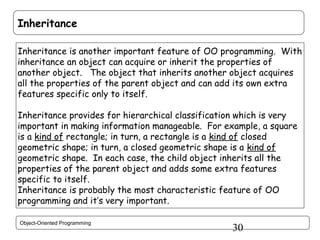


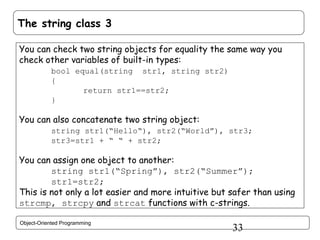
![The string class 4
You can use the << and >> operators to perform input and output. For
example:
main()
{
string first_name,last_name, full_name;
cout<<“Enter your first and last name: “;
cin>>first_name>>last_name;
full_name=first_name + “ “ + last_name;
cout<<“You full name is “<<full_name<<endl;
cout<<“Your last name is spelled: “;
for(int i=0; i<str2.length(); i++)
cout<<last_name[i]; //last_name.at(i)
string str4;
cout<<“Enter your full name”;
getline(cin, str4);
cout<<“Hello ” +str4<<endl;
}
Object-Oriented Programming
34](https://image.slidesharecdn.com/oocnotes-131203051753-phpapp02/85/Object-Oriented-Programming-Using-C-34-320.jpg)
![The string class 5
As you can see, string objects are more flexible than c-strings. You
can use the subscript operators [] for accessing string characters
in string objects but there is a better way of doing this. To access a
specific character of a string object just use the at() member
function which is safer than [] operators. (see the comment on 31)
Look at the following two fragments of code:
string str(“Dean”);
cout<<str[6];
string str(“Dean”);
cout<<str.at(6);
For the first version the compiler might not give an error message
although it should, but in the second version will terminate the
program so you know something is wrong.
Also note the standalone function getline() which is similar to the
input stream getline() but works with string objects only.
Object-Oriented Programming
35](https://image.slidesharecdn.com/oocnotes-131203051753-phpapp02/85/Object-Oriented-Programming-Using-C-35-320.jpg)



![The string class 9
…more string functions:
str1<str2
str1<=str2
str1>str2 //lexicographical comparisons
str1>=str2 //lexicographical comparisons
str1.find(str2);
//returns index of first
// occurrence of str2 in str1
str1.find(str2, pos);
//same as above but search
// starts at position pos
str1.replace(start, num, str2)
//beginning at
//start, replace num chars with str2
As you can see there are many string functions and there are many
more but we will only be using the above for most of the time.
Also note that since a string is treated as a data type you can have
an array of strings as in:
string names[31];
Object-Oriented Programming
39](https://image.slidesharecdn.com/oocnotes-131203051753-phpapp02/85/Object-Oriented-Programming-Using-C-39-320.jpg)


![Exercises
2. Write a function that takes two integer arrays, of equal size, as
parameters. The function asks the user to fill the first array with
a mixture of positive and negative numbers. Then your function
should separate the positives from the negatives and write them
into the second array. The positives should go to the lower-indexed
locations and the negatives should go into the higher-indexed cells.
3. What does the following program do:
main()
{
char names[5][20];
for (int i=0; i<5; i++)
cin>>names[i];
for ( i=0; i<5; i++)
cout<<names[i]<<endl;
}
Object-Oriented Programming
42](https://image.slidesharecdn.com/oocnotes-131203051753-phpapp02/85/Object-Oriented-Programming-Using-C-42-320.jpg)

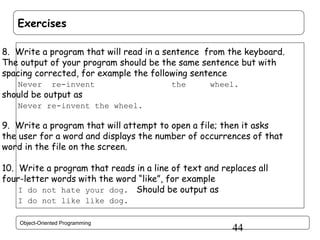
![Exercises
11. Write a function that takes a string array as parameter and
it should sort the elements of the array into alphabetical order.
Test your function in a driver program.
12. What would be the output of each of the following functions if
called with name as their parameter:
char name[]=“Mr Nice”;
void Print(char name[])
{
cout<<“Name: “<<name<<endl;
}
void Print(char *name)
{
cout<<“Name: “<<name<<endl;
}
Object-Oriented Programming
45](https://image.slidesharecdn.com/oocnotes-131203051753-phpapp02/85/Object-Oriented-Programming-Using-C-45-320.jpg)











![An Example 2
… continued
strtype::strtype()
{
p=new char(SIZE);
if(!p) {
cout<<“Allocation errorn”;
exit(1);
}
*p=‘n’;
//same as p[0]=‘n’
len=0;
}
strtype::~strtype()
{
cout<<“Freeing memoryn”;
delete p;
}
Object-Oriented Programming
57](https://image.slidesharecdn.com/oocnotes-131203051753-phpapp02/85/Object-Oriented-Programming-Using-C-57-320.jpg)


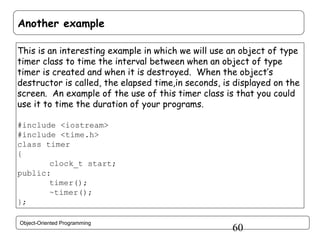








![Assigning Objects 2
But assigning objects can be dangerous sometimes. Can you identify
the problem with this example:
class mystring
{
char *p;
int len;
public:
mystring(char *ptr);
~mystring();
void show();
};
mystring::mystring(char *ptr)
{
len=strlen(ptr);
p=new char[len+1];
if(!p) {
cout<<“Allocation errorn”; exit(1); }
strcpy(p, ptr);
}
Object-Oriented Programming
69](https://image.slidesharecdn.com/oocnotes-131203051753-phpapp02/85/Object-Oriented-Programming-Using-C-69-320.jpg)




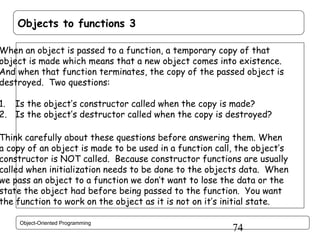



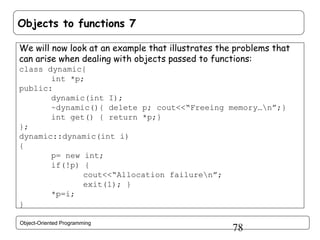










![Copy Constructors 2
Copy constructors have the following general form:
classname( const classname &obj)
{
//body of constructor
}
Here, obj is a reference to the object that is being used to initialize
another object. We use a copy constructor in the following example:
class array
{
int *p;
int size;
public:
array(int sz) { p=new int[sz]; if(!p) exit(1);
size=sz; cout<<“Normal constructor…”<<endl; }
~array() { delete [] p;}
Object-Oriented Programming
89](https://image.slidesharecdn.com/oocnotes-131203051753-phpapp02/85/Object-Oriented-Programming-Using-C-89-320.jpg)
![Copy Constructors 3
//copy constructor
array(const array &obj);
void put(int i, int j) {
//boundary check
if(i>=0 && i<size) p[i]=j;
}
int get(int i) {
return p[i];
}
array::array(const array &obj) {
int i; p=new int [obj.size];
if(!p) exit(1);
for(i=0; i<obj.size; i++) p[i]=obj.p[i];
cout<<“Copy constructor…”<<endl;
}
Object-Oriented Programming
90](https://image.slidesharecdn.com/oocnotes-131203051753-phpapp02/85/Object-Oriented-Programming-Using-C-90-320.jpg)





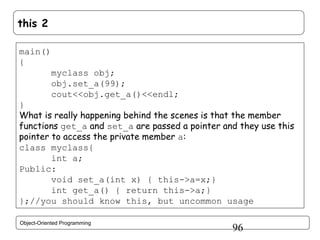


![Exercises
31. Given the declaration of an array of objects as follows:
sample ob[4]={1,2,3,4};
Write the definition of the class sample so that the above
declaration is legal.
32. Add a copy constructor function to the following class
definition:
class strtype{
char *p
public:
strtypr(char *p);
~strtype() { delete [] p;}
char *get() {return p;}
}
Object-Oriented Programming
99](https://image.slidesharecdn.com/oocnotes-131203051753-phpapp02/85/Object-Oriented-Programming-Using-C-99-320.jpg)
![Exercises
strtype::strtype(char *s)
{
int l;
l=strlen(s);
p=new char [l];
if(!p) exit(1);
strcpy(p, s);
}
void show(strtype str)
{
char *s;
s=str.get();
cout<<s<<“n”;
}
Object-Oriented Programming
100](https://image.slidesharecdn.com/oocnotes-131203051753-phpapp02/85/Object-Oriented-Programming-Using-C-100-320.jpg)


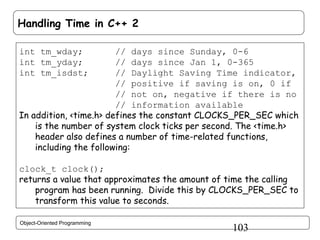
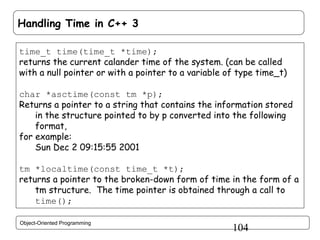
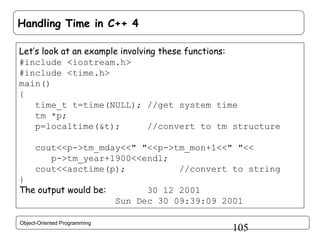



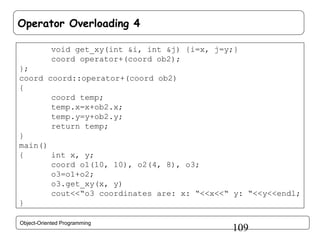



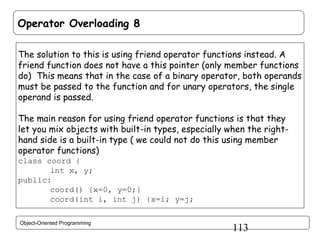

![Operator Overloading 10 (Assignment Operator)
By default, when the assignment operator is applied to an object, a
bitwise copy of the object on the right is put into the object on the
left. If this is what you want, OK, no need to worry about anything.
But, as you already know, in some cases a bitwise copy is not
desirable; for example when dealing with dynamic memory.
The solution is to provide an overloaded assignment operator:
mystring &mystring::operator=(mystring &ob){
if(len<ob.len) {
//if more memory is needed
delete [] p;
p=new char [ob.len];
if(!p) exit(1);}
len=ob.len;
strcpy(p, ob.p);
return *this;
}
Object-Oriented Programming
115](https://image.slidesharecdn.com/oocnotes-131203051753-phpapp02/85/Object-Oriented-Programming-Using-C-115-320.jpg)

![Exercises
37. Add two constructor functions to the following class so that
Both declarations inside main() are valid.
class samp
{
int a;
public:
// add 2 constructors here
};
main()
{
samp ob(99);
//initialize ob’s a to 99
samp ob_array[10];//non-initialize 10-member array
//…
}
Object-Oriented Programming
117](https://image.slidesharecdn.com/oocnotes-131203051753-phpapp02/85/Object-Oriented-Programming-Using-C-117-320.jpg)
















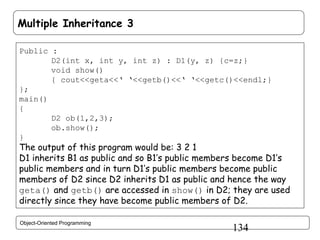







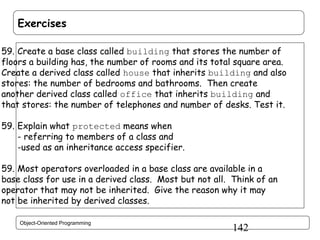
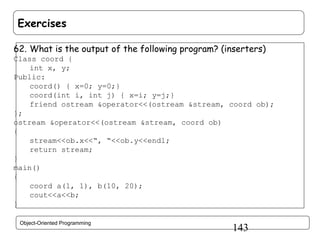


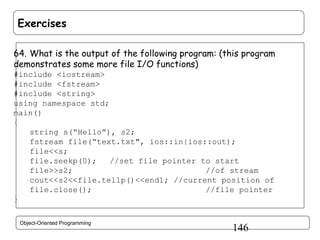



















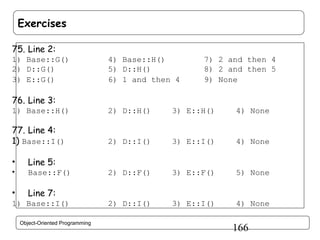





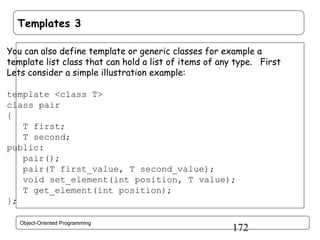




![Templates 8
Finally, here is the implementation file:
template <class T>
list<T>::list(int max) {
max_length=max;
current_length=0;
item=new T[max];
if (item==NULL) exit(1);
}
template <class T>
list<T>::~list() {
delete [] item;
}
template<class T>
int list<T>::length() {
return current_length;
}
Object-Oriented Programming
// --->
177](https://image.slidesharecdn.com/oocnotes-131203051753-phpapp02/85/Object-Oriented-Programming-Using-C-177-320.jpg)
![Templates 9
template <class T>
void list<T>::add(T new_item) {
if(full())
exit(1);
else
{
item[current_length]=new_item;
current_length=current_length+1;
}
}
template <class T>
bool list<T>::full() {
return (current_length==max_length);
}
// --->
Object-Oriented Programming
178](https://image.slidesharecdn.com/oocnotes-131203051753-phpapp02/85/Object-Oriented-Programming-Using-C-178-320.jpg)
![Templates 10
template <class T>
ostream& operator <<(ostream& out, const list<T>& the_list)
{
for(int i=0; i<the_list.current_length;
out<<the_list.item[i];<<endl;
return out;
}
As you saw, the only difference between template classes and
ordinary classes is that in template classes, you have a parameter
type (called the base type) and not a specific type.
In this example, an array was used to represent a list. But arrays
are not ideal in situations where you don’t know in advance how many
items they will store. Linked lists, as you know, solve this problem
Object-Oriented Programming
179](https://image.slidesharecdn.com/oocnotes-131203051753-phpapp02/85/Object-Oriented-Programming-Using-C-179-320.jpg)
![Templates 11
Template classes, like template functions are useful when they
contain logic which is general as you saw in the previous example.
Here is another example in which a generic stack class is created
which can be a stack of any type of objects:
#define SIZE 10
//define a constant
Template <class T> class stack {
T stack1[size];
int tos;
//index of top of stack
Public:
stack() { tos=0;}
void push(T obj);
T pop();
};
Object-Oriented Programming
180](https://image.slidesharecdn.com/oocnotes-131203051753-phpapp02/85/Object-Oriented-Programming-Using-C-180-320.jpg)
![Templates 12
Template <class T> void stack<T>::push(T obj){
if(tos==SIZE){
cout<<“Stack is full”;
return;
}
stack1[tos]=obj;
tos++;
}
Template <class T> T stack<T>::pop(){
if (tos==0) {
cout<<“stack is empty”;
return 0;
}
tos--;
return stack[tos];
}
Object-Oriented Programming
181](https://image.slidesharecdn.com/oocnotes-131203051753-phpapp02/85/Object-Oriented-Programming-Using-C-181-320.jpg)



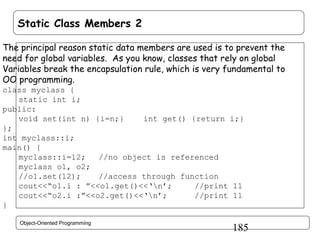



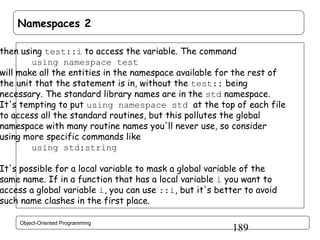






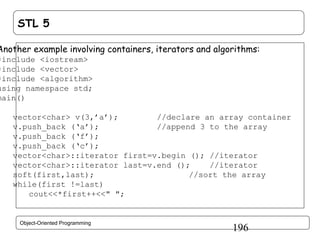
![STL 6
Yet another example:
#include <iostream>
#include <vector>
#include <algorithm>
using namespace std;
main()
{
vector<float> v(4,1.5);
for(int k=0; k<4, k++)
cout<<v[k]<<“ “;
vector<float> new1_v(v);
vector<float> new2_v=v;
vector<float> new3_v(v.begin(),v.end());
(new1_v==new2_v) && (new2_v==new3_v) ? cout<<“Equal” :
cout<<“Different”;
cout<<v.capacity()<<endl;
}
Object-Oriented Programming
197](https://image.slidesharecdn.com/oocnotes-131203051753-phpapp02/85/Object-Oriented-Programming-Using-C-197-320.jpg)
![STL 7
Yet one more example:
#include <iostream> #include <vector> #include <algorithm>
main()
{ vector<double> a;
a.empty() ? cout<<“Empty” : cout<<“Not empty”; //empty
vector<string> v(2,”string”);
vector<string> w(2, “word”);
v.swap(w);
//swap v and w
cout<<v[0]<<endl;
//word
vector<int> z(3,5);
z.push-back(8);
cout<<z.front()<<“ “<<z.back()<<endl; //5 8
cout<<z.size()<<endl;
//4
z.pop-back()<<endl;
//5 5 5
cout<<z.size()<<endl; //3
cout<<z.back()<<endl;
//5
}
Object-Oriented Programming
198](https://image.slidesharecdn.com/oocnotes-131203051753-phpapp02/85/Object-Oriented-Programming-Using-C-198-320.jpg)
![STL 8
And another example: (the insert & erase functions)
#include <iostream> #include <vector>
main(){
vector<int> v;
//vesrion 1 of insert
v.insert(v.begin(),6);//first argument is an iterator
cout<<v.capacity()<<endl;
cout<<v[0]<<endl;
vector<int> w;
w.insert(w.begin(), 2, 9);
//9 9
vector<int> x(1,3);
x.insert(x.end(), v.begin(),v.end()); // 3 9 9
vector<float> z(4, 7.5);
//7.5 7.5 7.5 7.5
z.insert(z.begin (),44);
//44 7.5 7.5 7.5
z.insert(z.end (),66);
//44 7.5 7.5 7.5 66
z.erase(z.begin());
//7.5 7.5 7.5 66
z.erase(z.begin(),z.end());
//same as v.clear()
}
Object-Oriented Programming
199](https://image.slidesharecdn.com/oocnotes-131203051753-phpapp02/85/Object-Oriented-Programming-Using-C-199-320.jpg)
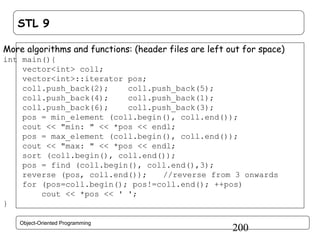


![STL 12
A vector stores its elements contiguously in memory. Because of
that it is easy to access an element directly by its position, using
the subscripting operator []. That also allows vector's iterators to
be random access iterators.
However, the way vector stores its elements also makes it hard to
insert and remove them. Because it has to keep everything in one
single chunk of memory, outgrowing it means allocating a bigger
chunk and copying all elements to this new place, and this may be
very slow. When you insert or remove an element in the middle of a
vector, all subsequent elements have to change position. This is
expensive and makes all iterators that reference those relocated
elements invalid.
Inserting/removing at the end of vectors is cheap and quick.
Object-Oriented Programming
203](https://image.slidesharecdn.com/oocnotes-131203051753-phpapp02/85/Object-Oriented-Programming-Using-C-203-320.jpg)








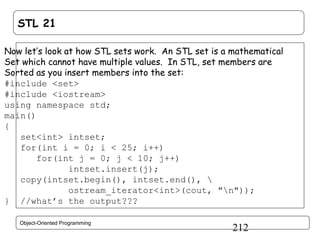
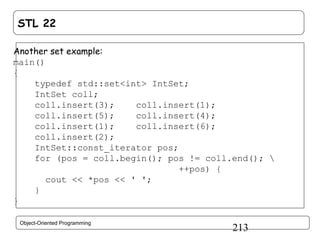

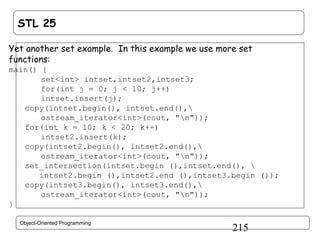
![STL 26
Anything that can have the operator () applied to it is a function
object. A function’s name is an example of a function object:
#include <algorithm>
using namespace std;
void printing_function (int i)
{
cout << i << ' ';
}
main()
{
int A[] = {1, 4, 2, 8, 5, 7};
const int N = sizeof(A) / sizeof(int);
for_each(A, A + N, printing_function);
}//for_each is algorithm
Object-Oriented Programming
216](https://image.slidesharecdn.com/oocnotes-131203051753-phpapp02/85/Object-Oriented-Programming-Using-C-216-320.jpg)



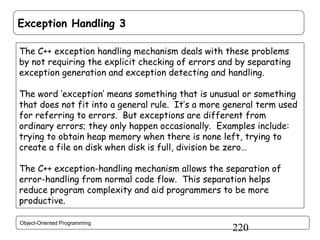


![Exception Handling 6
If you throw an exception for which there is no matching catch
Statement, an abnormal program execution may occur. Exceptions
Must be thrown only from within a try block; or from a function
Which is called inside a try block.
Exceptions can be of any type, including user-defined classes:
class my_exception {
public:
char str_what[20];
int what;
my_exception(char * s, int s) {
strcpy(str_what,s); what=e;
}
};
Object-Oriented Programming
223](https://image.slidesharecdn.com/oocnotes-131203051753-phpapp02/85/Object-Oriented-Programming-Using-C-223-320.jpg)



























![[OOP - Lec 19] Static Member Functions](https://cdn.slidesharecdn.com/ss_thumbnails/lecture-19staticmemberfunctions-160705095235-thumbnail.jpg?width=560&fit=bounds)






































































